|
|
|
|
|
This is an annotated history based on extant Daruma artwork (80+ photos).
It is presented in approximate chronological order, and can be read as a
whole or sectionally. To improve readability, info is sometimes repeated.
Written principally as a “Daruma Primer” for students & teachers of art history.
Do not copy these pages into Wikipedia or elsewhere without proper citation !
DARUMA - Father of Zen Buddhism
From Buddhahood to Brothel, From Saint to Sinner
The Evolution of Daruma Artwork in Japan

Sanskrit = Bodhidharma; a sage from India
Chn. = Pútídámó 菩提達磨, Dámó, Damo, Tamo
Jp = Daruma 達磨, Bodaidaruma 菩提達磨
Jp. = Daruma Daishi 達磨大師, Krn. = Dalma, Talma 달마
Tibetan = Bodhidharmottāra or Dharmottāra; considered an Arhat.
In Tibet/China/Japan, he is an avatar of Avalokitêśvara (J = Kannon).
In Japan, famous monks like Gyōki & Eisai are his avatars.
In Tamil Nadu (southern India), he is known as போதிதர்மன்
Bodhi = Enlightened, Dharma = Universal Law. Details Here. DEFINITIONS:
BODHI (Sanskrit): Enlightened, Enlightenment. The opposite of Avidya (Sanskrit), the latter meaning ignorance or self delusion, or the belief that one's self is distinct from the external world. The true self incorporates the realization that both are aspects of the same "Buddha Nature."
DHARMA (Sanskrit): This term has numerous meanings, but the two most essential definitions are (1) Teachings of the Buddha; and (2) Universal Law, or the law upon which all life processes are based.
CONFUSION: A 5th-century monk from Kashmir named Dharmatrata has been confused with Bodhidharma, with Dharmatrata's lineage becoming Bodhidharma's lineage -- the result? Bodhidharma himself is known in Tibet as Bodhidharmatrata. In the Tibetan tradition, Dharmatrata, along with the Northern Chan master Mahayana, were added to the list of 18 Arhats. Source of Last Entry = Faure. |
|
|
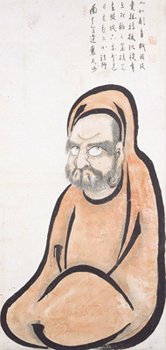
Bodhidharma (Daruma) 達磨図
By Hakuin Ekaku 白隠慧鶴 (1685-1768). H 122.0 cm x W 58.2.
Tokeii Temple 東慶寺, Kamakura
|
|
|
|
 The historical Bodhidharma (known as Daruma in Japan) was an Indian sage who lived sometime in the fifth or sixth century AD. He is commonly considered the founder of Chan (Zen) Buddhism 禅, and credited with Chan's introduction to China. (Important Note: Zen is the term used in Japan, but Daruma’s philosophy arrived first in China, where it flowered and was called Chan Buddhism. Only centuries later does it bloom in Japan, where it is called Zen). Practically nothing is known about Bodhidharma or his teachings. Early Chinese texts provide scant information, except to say he was a pious monk from Indian who came to China and introduced a form of meditation that involved “gazing at cave walls.” Only one of the ten texts DEFINITIONS:
In the early part of the 20th century, a great cache of manuscripts dating to China's Tang period (618-907), were discovered in Dunghuang, China. Among them was the Treatise on the Two Entrances and Four Practices, attributed to Bodhidharma (but recorded by his disciple Tanlin). Modern scholars such as John McRae and Jeffrey Broughton see no reason to doubt this attribution. Much has been gleaned from this discovery, including biographical information on Daruma, documents believed to be Bodhidharma's teachings, and two letters to Huike, along with the latter's reply. Both McRae and Broughton provide full English translations with commentary. attributed to Bodhidharma is presently considered authentic. < Broughton, p. 4> The lack of robust historical evidence concerning Bodhidharma, paradoxically, is offset by countless legends about this sage. Legends come in two varieties -- the orthodox Chinese version, and the far more fanciful Japanese version. Both versions are considered largely apocryphal, containing layer upon layer of embellishments and legendary accretions spanning many centuries. Modern scholars and art historians are trying to discern the underlying historical figure by stripping away the ideological, idealizing, & idolizing accretions. <SourcesREFERENCES: See, for example:
Bodhidharma as Textual and Religious Paradigm by Bernard Faure (History of Religions, Vol. 25, No. 3, 1986, pp.187-198) or
Why did the Patriarch Cross the River? The Rushleaf Bodhidharma Reconsidered by Charles Lachman (Asia Major, Vol. 4, Pt. 2, 1993, Pages 257-264), or
Awakenings: The Development of the Zen Figural Pantheon by Yukio Lippit (Japan Society, 2007), or
The Bodhidharma Anthology: The Earliest Records of Zen by Jeffrey L. Broughton (University of California Press, Aug.1999).
CHINESE LEGENDS. The best-known Chinese legends say he was the third son of a Brahman king from southern India [possibly from Tamil Nadu) and studied under the tutelage of Prajñātāra 般若多羅 (Jp.. = Hannyatara), the 27th Indian Patriarch in a direct mind-to-mind line of transmission from the Historical Buddha. Bodhidharma achieved enlightenment (Japanese = satori さとり), becoming the 28th Indian Patriarch in that lineage (Nijūhasso 二十八祖), and then, in accordance with instructions from Prajñātāra, he traveled to China to transmit the Mahayana teachings. After a perilous three-year sea voyage, he finally reaches Canton (China), whereupon he makes his way to the court of the Liang Dynasty in Nanking (Nanjing) and speaks with Emperor Wu (Liáng Wǔdì 梁武帝; Jp. = Ryō Butei). The pious monarch, one of China’s most fervent patrons of Buddhism, is told that his building of temples, ordaining of monks, carving of Buddha statues, and copying of sutras has no karmic merit (see story here). The emperor is puzzled and perhaps annoyed, so Bodhidharma makes a quick getaway, heading northward to Shaolin Temple (Jp. = Shōrinji 少林寺) on Mt Song (Jp. = Sūzan 嵩山) in the state of Wei. To reach his destination, he must cross the mighty Yangtze River (artwork of this scene shows him crossing the river while balanced atop a tiny reed). At Shaolin Temple, he meditates for nine years in a cave, gaining the name Wall-Gazing Brahman 壁觀婆羅門 (Chn. = Bìguān Póluómén; Jp. = Hekikan Baramon or Menpeki Daruma 面壁達磨; literally the “wall-facing” or “wall-gazing” Bodhidharma.)
Bodhidharma’s new meditation technique attracts few students, but one of them, Huìkě 慧可 (Jp. = Eka), is so eager to become Bodhidharma’s student that he stands outside the cave in the snow and waits one whole week for the master’s attention and then Huìkě cuts off his own left arm and presents it to the master to demonstrate his determination to attain enlightenment (this scene is also represented in artwork). Huìkě eventually becomes Bodhidharma’s successor. Despite two unsuccessful attempts by rivals to poison Bodhidharma, the sage knowingly takes poison on their third attempt, and dies at the age of 150. Three years later, in the Pamir mountains, a Chinese diplomat named Sòng Yún 宋雲 is returning to China from a trip to the West when he meets Bodhidharma, who is on his way back to India, walking barefoot and carrying one shoe in his hand. When the diplomat finally gets home, and tells this story, the master’s grave is opened and all that is found is one shoe. Bodhidharma is thereafter considered a type of Taoist Immortal, one who feigned his own death. <Faure>. Bodhidharma is also, according to some, the founder of Shaolin martial arts and Kung Fu, although such views are now largely discredited. This, in a nutshell, is the Chinese version of the Bodhidharma story. <See Broughton for more details>
JAPANESE LEGENDS. Japanese stories about Daruma (Bodhidharma’s name in Japan) go far beyond Chinese legends -- they are overlaid with a wealth of new mythology and superstition involving popular culture and local Japanese folkloric motifs related to astral deities, gods of the crossroads, epidemic spirits, fertility, and more. According to the Japanese, Daruma’s arms and legs supposedly atrophied, shriveled up, and fell off during his nine-year meditation marathon facing a cave wall in China. During that time, Japanese legend also credits Bodhidharma with plucking out (or cutting off) his eyelids. Apparently he once fell asleep during meditation, and in anger, he cast them off. The eyelids fell to the ground and sprouted into China's first green tea plants. As we know, Zen's assimilation into Japanese culture was accompanied by the introduction of green tea, which was used to ward off drowsiness during lengthy zazen sessions. Additionally, Japan’s medieval Tendai sect claims that Bodhidharma did not return to India but journeyed onward to Japan, where he met Prince Shōtoku Taishi (574 - 622 AD), the first great patron of Buddhism in Japan, and from this association, Daruma is also linked (in Japanese myth) to horses and monkeys. Details here.
The origin of these Japanese legends is hard to pinpoint. Zen came to prominence in Japan during the Kamakura period (1185-1333), although Zen teachings had entered Japan centuries earlier via China. In traditional Japanese Zen artwork (from the medieval period), Daruma is typically portrayed as a pious, stern-faced, red-robed monk pointing the way to enlightenment. But in later centuries, Daruma came to serve a wide variety of different roles. Beginning sometime in the 16th century, red-colored Daruma images became popular talismans to protect children against smallpox (the smallpox god was said to like the color red, and could therefore be pacified by red offerings). By the 18th century, red-colored Daruma dolls (with no arms or legs) were also sold to ward off smallpox. Smallpox disappeared after vaccination was introduced to Japan in the Meiji period (1868-1912), but the bright red Daruma dolls remained extremely popular as good-luck charms -- today they are one of Japan’s most ubiquitous icons of good fortune. Painting in the eyes of Daruma dolls is a widespread modern practice to ensure success in business, marriage, politics, and other endeavors.
Daruma dolls are also called “tumbler dolls” (okiagari koboshi 起き上がり小法師), for when knocked on their side, they pop back to the upright position and therefore symbolize (1) a speedy recovery from illness, akin to "getting back on one's feet" and (2) resilience, undaunted spirit, and determination. Since Daruma dolls appeared without any bodily appendages, they lent themselves easily to phallic symbolism (that which falls and soon rises again is the penis), and Daruma therefore became a subject of parody by Edo-era artists who often portrayed him alongside courtesans. Says scholar Bernard Faure: “Until the Meiji period, phallic representations of Daruma in stone or papier mache were sold. The name ‘Daruma’ was also a nickname given in the Edo period to prostitutes, perhaps because, like the doll, these specialists of tumble could ‘raise’ the energy of their customers. Daruma is indeed often represented [in artwork] in comical fashion in the company of a prostitute....or as part of a legitimate couple called ‘Mr. and Mrs. Daruma’ .......these Daruma dolls protected children against illnesses and were supposed to facilitate childbirth, bring good harvest, and more generally bring prosperity to their owners.” <end quote B. Faure> The list of Daruma’s roles is seemingly endless. He also serves, for example, as a talisman for sericulture and is thus connected with silkworms.
One final point. In Japanese woodblock prints (Ukiyo-e 浮世絵) and paintings from the 17th century onward, Daruma is depicted more and more as weak, vain, and desirous, unable to escape the same foibles and illusions faced daily by the common folk. This latter “down-to-earth” Daruma is the deity who is today beloved by the Japanese -- not the scruffy old man in portrait paintings who stares at a wall !! Since the Edo period, Daruma has served as a source of parody, laughter, and ribaldry, more willing to dress in the clothes of a woman or manifest himself as a female than to remain forever chained inside his cave as a lofty symbol of immovable equanimity divorced from ordinary life. Poor Daruma. Japan’s own scholars don’t know how to categorize him in their deity dictionaries. In both old and new lexiconic works, Daruma fails to appear as a Buddha or a Bodhisattva. Rather, he appears in the closing chapters as one of Japan’s so-called “Eminent Monks” -- or he doesn’t appear at all. Despite this quibble, Daruma in modern Japan is a living icon, not a dead one. Daruma has forgone the rarified and perfumed abode of the gods and instead gotten “down and dirty.” He lives among sinners, prostitutes, the uneducated, gamblers, farmers, the poor, the salaryman, and all who suffer daily. Daruma’s aim is not to retire from the world into solitary meditation, but to stay in close touch with the ordinary labors of the people, to live not away from the community but within the community, forever carrying out the Bodhisattva’s task of bringing compassion and wisdom to all. This seems (to me) to be in the true spirit of Zen, for in the end, the great truth of Zen is possessed by everyone, and the only way to gain salvation, as D.T. Suzuki REFERENCES:
An Introduction to Zen Buddhism by Daisetsu Teitaro (D.T.) Suzuki, page 25. 
|
Daruma Portraits in Japanese Artwork
|
|
Daruma was a favorite subject of Japanese painters, and a wide variety of brush and ink paintings are still extant. The most common portraits emphasize Daruma’s ”Indian (foreign)” appearance, and thus he is often portrayed as a scraggly man with bushy eyebrows and beard, a big nose, elongated ears (a symbol of enlightened beings), large circular earrings, and staring eyes without eyelids. The oldest extant portrait painting of Daruma in Japan (to my knowledge) is a hanging scroll of a seated Daruma dressed in a red robe at Kōgaku-ji Temple 向嶽寺 (Kōshū City, Yamanashi) dated to the Kamakura era (circa 1260 AD). See photo below. Portrait paintings of prominent monks and people are considered innovations of the Kamakura period, with the Zen sect in particular pursuing this form of expression. This explains why portraitures and paintings of Daruma in Japan far outnumber sculptural representations of the Zen patriarch. Portrait paintings of Japan’s Zen masters served multiple functions, e.g., as a form of homage to the founders of Zen Buddhism, as an aid to help practitioners reach enlightenment, as a certificate given by a Zen teacher to a student to acknowledge the student's attainment of spiritual awareness, as a symbol confirming the unbroken lineage of a sect, or as an image used in memorial services at Zen temples. Keyword = Zenshū Soshizō 禅宗祖師像 (lit. Portraits of Zen Patriarchs).
|
|
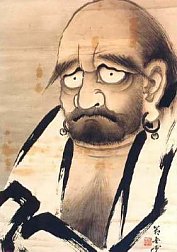
Bodhidharma (Daruma), 15th C.
by Shōkei (Keishōki) 祥啓 (d. 1518?)
Nanzenji Temple 南禅寺, Kyoto
|
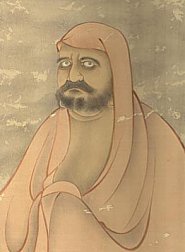
Bodhidharma (Daruma)
by Soga Jasoku 曽我蛇足 (d. 1483)
Yōtokuin Temple 養徳院, Kyoto
Photo Baxleystamps.com
|
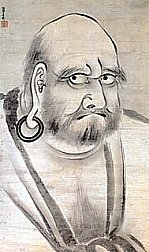
Bodhidharma (Daruma) 15th C.
by Shōkei 祥啓 (d. 1518?)
Nanzenji Temple 南禅寺
|
|

Bodhidharma (Daruma)
Unsigned, Hanging Scroll
H 76.5 cm, W 39.0.cm, Late 16 C.
Photo courtesy British Museum
|

Bodhidharma (Daruma)
by Takeda Mokurai 竹田黙雷 (1854-1930)
Kennin-ji Temple 建仁寺 (Kyoto).
See full image here. Photo Schumacher.
|

Bodhidharma (Daruma)
by Kanō Chikanobu 狩野周信
(1660-1728). Ink & Colors on Silk
Pacific Asia Museum
|
|
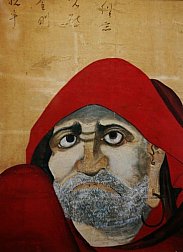
Daruma-zu 達磨図, Edo Period
by Shiba Kōkan 司馬江漢 (1747-1818)
At Renzōji Temple 蓮蔵寺 (Mie Pref.)
Photo from this J-site.
|

Daruma ga Koronda, Edo era
ダルマサンガコロンダ, 洗昇画
Waseda University Library Catalog
Photo: Wasea University Library
|
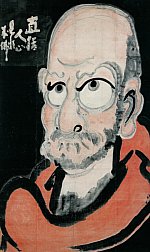
Daruma-zō 達磨像, Edo Era, by
Hakuin 白隠慧鶴 (1685-1768)
Manjuji Temple 萬壽寺, Oita Pref.
Photo: Kyushu Nat’l Museum
|
|
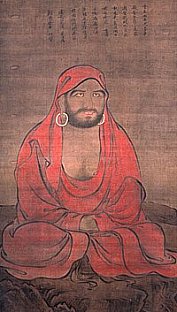
Red-Robed Bodhidharma.
Painter unknown. National Treasure. Inscribed by Lánxī Dàolóng 蘭溪道隆 (1213–1278). Kamakura era, 1260s. Japanese hanging scroll, ink & colors on silk; H 108.2 cm x W 50.6 cm. Treasure of Kōgakuji (Kogakuji) Temple 向嶽寺 (Yamanashi Pref.) This is not the original painting, but rather a modern reproduction from this J-site.
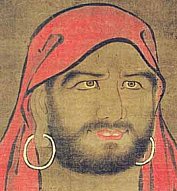
Closeup
|
RED-ROBED BODHIDHARMA (AT LEFT)
Says Yukio Lippit (Harvard University) in Awakenings: The Development of the Zen Figural Pantheon (Japan Society 2007): “This scroll, one of the earliest and most significant works of Zen figural subject matter to survive in Japan, depicts the first patriarch of China dressed and hooded in a red robe, seated cross-legged on a flat rock against a blank background. The implied setting of the painting is a mountain cave in the vicinity of the monastery Shaolin on Mt. Song in Henan Province, where Bodhidharma is said to have meditated facing a wall for nine years after a frustrating encounter with Emperor Wu of China’s Liang dynasty. The inscription is by Lánxī Dàolóng 蘭溪道隆 (Lanqi Daolong; Jp. = Rankei Dōryū; 1213–1278), a Chinese monk who came to Japan in 1246 and became the founding abbot of Kenchōji (Kenchoji) Temple 建長寺 in Kamakura. It reads as follows:
The youngest son of King Xiangzhi, the faithful follower of Prajnatara’s lineage. Seeing through the heretical views of the Six Sects in India He came to China and his teaching flowered into a beautiful five-petaled blossom, whose fragrance has now reached Japan. Auspicious signs are as endless as the Ganges. Shaolin Monastery -- the sprouting of the miraculous bud has not been hindered. Now it has rooted in the presence of a noble figure and is growing into an extraordinary flower. Respectfully inscribed for Layman Ronen by Lanqi Daolong, Abbot of Kenchoji. (Translation based upon Fontein and Hickman, Zen Painting and Calligraphy, p. 51, modified by the author.)
NOTE
- Laymen Ronen. The inscription and painting appear to have been produced for the young Kamakura regent Hōjō Tokimune 北条 時宗 (1251-1284) sometime during the mid-to late 1260s, soon after Lánxī was reappointed abbot of Kenchōji (one of Kamakura’s Great Five Zen Temples).
|
|
|
Episodes from Daruma’s Life as Artistic Themes
|
|

|
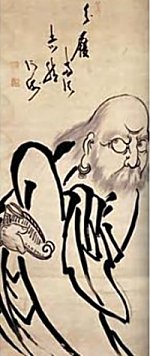
Sekiri Daruma 隻履達磨
One Shoe Daruma
By Hakuin Ekaku 白隠慧鶴
(1685-1768). Ink on Paper
H 126.4 cm, W 56 cm
Eisei Bunko Foundation
|
|
 In addition to imaginary or idealized Daruma portraits, paintings of this sage often illustrated major incidents in his legendary life. Four main episodes were used as painting subjects. Examples of each are presented below. In addition to imaginary or idealized Daruma portraits, paintings of this sage often illustrated major incidents in his legendary life. Four main episodes were used as painting subjects. Examples of each are presented below.
- Eka Danpi 慧可断臂. Literally “Eka cutting off his elbow.” Such paintings derive from the Chinese legend of Huìkě 慧可 (Huike; Jp. = Eka), who becomes Daruma’s successor and China’s second Chan (Zen) patriarch. Eka is so eager to become Bodhidharma’s student that he stands in the snow outside the cave (where Daruma is meditating) for one whole week and then cuts off his left arm and presents it to the master to demonstrate his resolve to undergo the hardships and rigors of Zen training. An early version of this legend appeared in the 8th-century Chinese text Denpō Hōki 傳法宝記・伝法宝記 (Chn. = Chuán fǎbǎojì, Chuanfabaoji).
- Menpeki Daruma 面壁達磨. Literally “Wall-Gazing Daruma.” Such paintings are based on the legend of Daruma meditating for nine years while facing a cave wall inside a cave near Shaolin Temple (China). This legend appeared by at least the mid-7th century in Chinese texts.
- Royō Daruma 蘆葉達磨 or 芦葉達磨. Literally “Reed Daruma.” This refers to a famous incident from his life, in which he crosses the Yangtze River on his way northward to modern-day Henan Province (China) while balanced on a tiny reed. Also sometimes translated at “Daruma on a Rush-Leaf” or “Daruma Crossing the Sea.” However, the first textual reference to this river crossing [on a reed] dates from 1108 and the legend didn’t become widespread until the 13th century.
- Sekiri Daruma 隻履達磨. Literally “One Shoe Daruma.” Such paintings feature Bodhidharma holding a single shoe and derive from the legend that Bodhidharma, after his death, came back to life and traveled home to India. On his return journey, a Chinese diplomat sees him walking barefoot and carrying one shoe in his hand. When the diplomat finally gets home, and tells this story, Bodhidharma’s grave is opened and all that is found is one shoe. Paintings of this theme are the least common among the four, but Helmut Brinker has identified one dated to 1296 and inscribed by Nanpō Shōmyō 嘉禎元年 (1235-1309).
|
|
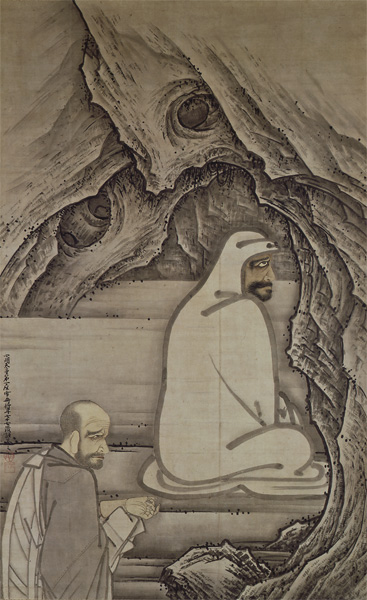
Eka Danpi 慧可断臂 (Lit. = Eka cutting off his elbow).
Hanging scroll, 1498. By Sesshū 雪舟 (1420-1506).
Sainenji Temple 斎年寺, Aichi Pref.
Photo from Kyoto National Museum
|
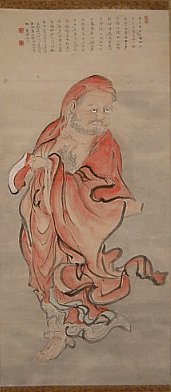
Sekiri Daruma 隻履達磨
Literally “One Shoe Daruma.”
By Ejō Shinkai 慧定真戒 (1784-1853)
Photo this J-Site
|
|
NOTES ON EKA DANPI. The story of Eka cutting off his elbow comes in various versions. In the Annals of the Transmission of the Dharma Treasure (Chuán fǎbǎojì 傳法寶記; Jp. = Denpō Hōki 伝法宝記), an early 8th-century Chinese text attributed to Dharma-master Dù Fěi 杜朏 (Jp. = Tohi), we are told that Eka travels to Shaolin Temple 少林寺 (Jp. = Shōrinji ) in modern-day Henan Province (China) to ask Bodhidharma to teach him zazen 坐禅 (sitting meditation). But when he arrives, he finds Bodhidharma immersed in a meditation technique called ”wall-gazing” 壁観 (Chn. = Bìguān, Jp. = Hekikan) or "wall facing" (Chn. = Miànbì, Jp. = Menpeki 面壁). Eka waits patiently in the snow for a long time (in some versions, for one week), until Bodhidharma informs him that Zen study requires discipline and hardship. Eka subsequently cuts off his arm and presents it to Bodhidharma as a sign of his sincerity and determination, as a sign of his willingness to undergo any sacrifice for the privilege of being Bodhidharma’s pupil. Says JAANUS: “Although the Eka Danpi story was not illustrated frequently, handscrolls by Dai Jin 戴進 (1388-1462; Liaoning 遼寧 Museum) and Yan Ciping 閻次平 (active ca. 1164-81; Cleveland Museum) and a hanging scroll by Sesshū 雪舟 (1498; Sainenji 斎年寺, Aichi Pref.), illustrate this theme.” <end JAANUS quote>
This story is commonly interpreted as meaning one must be prepared to make sacrifices -- to go to any lengths to demonstrate a desire to learn and pass on wisdom -- for Zen cannot be transmitted to any dolt, but only to those few who are fit to trust. Indeed, the author of the Chuán Fǎbǎo Jì implies that the people who commissioned this work had taken a wrong direction in making the teachings available to greater and greater numbers. <see The Northern School and the Formation of Early Chan Buddhism by John McRae (University of Hawaii Press, Jan. 1987); also see the Digital Dictionary of Buddhism (sign in with user name = guest). The Eka Danpi story also involves one of only three recorded interviews with Bodhidharma. In an oft-quoted passage from Zen literature, Eka has been accepted as Bodhidharma’s student, but receives no explanations from the master. So he asks:

“I have no peace of mind. Might I ask you, Sir, to pacify my mind?”
“Bring out your mind here before me,” replied Bodhidharma. “I shall pacify it.”
“But it is impossible for me to bring out my mind,” said the disciple.
“Then I have pacified your mind,” said Bodhidharma.
|
|
|
Daruma Crossing the Yangtze River
This famous theme did not appear in texts involving Daruma until the 12th century.
|
|
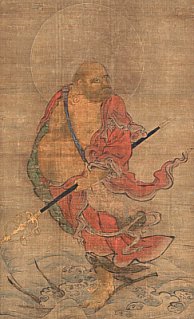
|
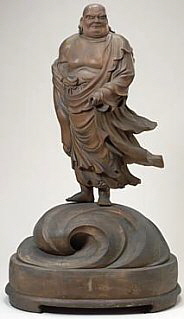
|
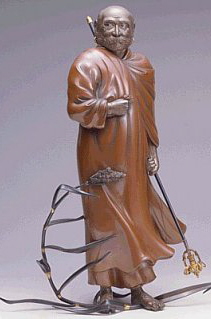
|
|
Daruma crossing the Yangzi River
on a Reed (Royō Daruma 蘆葉磨)
Painter unknown. Japanese, Nanbokucho era (1336–1392), Hanging scroll, ink/colors/gold on silk.
H = 69.0 cm x 40.6 cm.
Museum of Fine Arts, Boston
Photo: Asianart and Japan Society
|
Daruma crossing the sea.
Tokai Daruma 渡海達磨, by Niiro Chūnosuke 新納忠之介 (1869-1954).
Wood. H = 110.6 cm (w/o base).
Photo courtesy
University Art Museum, Tokyo Nat’l University of Fine Arts & Music
|
Daruma crossing the
Yangtze River on a Reed.
Royō Daruma 蘆葉磨
By Shō-ami Katsuyoshi
正阿弥勝義 (1832-1908).
Photo courtesy
of this J-site.
|
WHAT DOES THE REED SYMBOLIZE? From a conventional viewpoint, it might symbolize the miraculous feat of crossing a mighty river while balanced on a tiny reed, or it might refer to “crossing to the other shore,” or, as author John Stevens
REFERENCE: Stevens, John. 1991. New Orleans Museum of Art Zenga: Brushstrokes of Enlightenment.
REFERENCES: See, for example:
Bodhidharma as Textual and Religious Paradigm by Bernard Faure (History of Religions, Vol. 25, No. 3, 1986, pp.187-198) or
Awakenings: The Development of the Zen Figural Pantheon by Yukio Lippit (Japan Society, 2007), or
The Bodhidharma Anthology: The Earliest Records of Zen by Jeffrey L. Broughton (University of California Press, Aug.1999), or
Notes on Daruma Crossing the River, artwork by Nantembo (1839-1925) at the Bachmann-Eckenstein Exhibition 1991).
Faure writes: "The oldest treatment of the [river crossing] theme dates from the beginning of the thirteenth century and it contains an inscription by Rujing (1163-1228), the master of the founder of the Soto school of Zen in Japan, Dogen (1200-1253). A second painting, preserved in Japan, shows an inscription by the Chan master Wuzhun Shifan (1177-1249). There is also an estampage on stone, dated from the mid-eleventh century, from the Shaolin monastery. A first study of the theme was made by Li Chu-tsing. Li focuses on a painting by Ding Yunpeng, preserved in the Charles A. Drenowatz Collection in Zurich."
Say Bachmann-Eckenstein: "Bodhidharma's mysterious crossing the Yangzi River on a rush leaf has first been mentioned in the 13th century: The Wudeng huiyuan, edited in 1252 by Dachuan Puji (1179-1253), the Wujia zhangzong zan, compiled two years later by Xisou Shaotan (d. 1279) and the Shishi tongjian, in 1270 by Ben Jue state Bodhidharma's breaking off a rush leaf and crossing the Yangzi river. But these sources do not indicate the use of the rush leaf as a vehicle. This aspect probably was introduced later to compensate Bodhidharma's fruitless visit at the emperors court. Earlier sources as the Jingde chuandeng lu (J. Kidoroku) compiled by Xutang Zhiyu (J. Kido Chigu, 1185-1269), in the years 1004-07 or the Chuanfa zhengzong ji, 1060 do not mention any rush leaf at all. (Brinker/Kanazawa 1993, 208). Zen practice has had little use for miraculous deeds, stressing instead the enlightenment of the everyday world. The Chinese character that originally meant both reed boat and reed lost its first meaning over the course of time. This inspired the idea that Daruma had crossed on a reed rather than in a reed boat. (Addiss 1989, p 57)."
REFERENCE: Lachman, Charles. 1993.Why did the Patriarch Cross the River? The Rushleaf Bodhidharma Reconsidered. Asia Major, vol. 4, pt. 2 (1993), Page 257-264.
 MIDDLE PHOTO ABOVE. In Faith & Power in Japanese Buddhist Art, 1600-2005, page 215, author Patricia J. Graham writes: “Chūnosuke’s graduation piece for the Tokyo School of Fine Arts in 1894 displays the qualities that made his work much admired. It embodies the aims of the school, which sought to resurrect the dynamism of ancient sculpture but simultaneously capture a sense of modernity. Chūnosuke portrayed Daruma during a famous incident from his life, miraculously crossing the Yangtze River to reach the north of China while balanced on a tiny reed. Premodern Japanese artists had typically represented this subject in painting rather than sculpture. By altering the medium, Chūnosuke created an unexpected interpretation of a venerable theme, endowing the patriarch with an unprecedented sense of corporality. Still, the billowing robes, fleshy chest, and facial expression undoubtedly derive from the artist’s close study of old sculptures of the Nara and Kamakura periods.” <end quote> Here we might add that Chūnosuke entitled the piece MIDDLE PHOTO ABOVE. In Faith & Power in Japanese Buddhist Art, 1600-2005, page 215, author Patricia J. Graham writes: “Chūnosuke’s graduation piece for the Tokyo School of Fine Arts in 1894 displays the qualities that made his work much admired. It embodies the aims of the school, which sought to resurrect the dynamism of ancient sculpture but simultaneously capture a sense of modernity. Chūnosuke portrayed Daruma during a famous incident from his life, miraculously crossing the Yangtze River to reach the north of China while balanced on a tiny reed. Premodern Japanese artists had typically represented this subject in painting rather than sculpture. By altering the medium, Chūnosuke created an unexpected interpretation of a venerable theme, endowing the patriarch with an unprecedented sense of corporality. Still, the billowing robes, fleshy chest, and facial expression undoubtedly derive from the artist’s close study of old sculptures of the Nara and Kamakura periods.” <end quote> Here we might add that Chūnosuke entitled the piece Tokai Daruma 渡海達磨 (Daruma Crossing the Sea) and replaced the reed with a powerful rolling wave.
|
|
|
Daruma, Epidemic Diseases, Smallpox, Owls, Dogs, & Toys
Special thanks to GABI GREVE for introducing many of these images to me.
|
For obscure and complex reasons, images of Daruma (often accompanied by an owl, small puppy, and/or toy) became talismans against smallpox in Japan’s Edo period (1615-1868). Such images were often red, for the smallpox deity (Hōsō Kami 疱瘡神) was said to like the color red, which symbolizes, among other things, scarlet fever, tuberculosis, and measles, as well as fertility, childbirth, and the caul (the embryonic membrane covering the head at birth). In those days, the common folk tried to please the smallpox deity with red images (Aka-e 赤絵, lit. "red prints;" also known as Hōsō-e 疱瘡絵, lit. “smallpox prints”) in the hopes of averting illness or being granted a speedy recovery. Says Bernard Faure: “A Daruma doll was usually offered with other auspicious toys to sick children. The altar to the smallpox god was decorated with red paper strips (gohei 御幣), a Daruma doll, and an owl (みみずく); sometimes also of a doll called shōjō 猩猩 or 猩々(orangutan or ape or monkey). Furthermore, the sick child had to wear a red hood.” Faure also says “Daruma became popular in the Edo period, probably as the result of a complex evolution, which metamorphosed him from a malevolent spirit to a crossroad deity,Daruma as a Malevolent SpiritGoryou, Goryo = Malevolent spirit, avenging spirit, vengeful spirit, angry spirit. Since at least the Heian period, the Japanese have gone to great lengths to appease the spirits of those wrongfully killed or to correct an injustice they suffered -- otherwise, those spirits would return to wreak havoc on the living. The most famous case is that of Sugawara no Michizane (+845 - 903 AD), a courtier in the Heian period. Michizane was deified after death, for his demise was followed shortly by a plague in Kyoto, said to be his revenge for being exiled. Daruma's wrongful death (he was poisoned) gave him the aura of a vengeful spirit. Interestingly enough, Prince Shotoku Taishi himself, who is connected with Daruma via the legend of the Kataoka beggar, died under suspicious circumstances as well, followed two months later by the death of his wife, and a few years later by the death of his son, who was forced to commit suicide by the Soga clan leader, thereby ending Shotoku's direct family line. Shotoku has thus been portrayed as an angry spirit. Says Bernard Faure: Daruma at the Crossroad. We have seen how the figure of Bodhidharma inserted itself into the legend of Shotoku Taishi through the intermediary of the Kataoka beggar. According to Hartmut Rotermund, Shotoku Taishi's gift of a poem was perhaps aimed at revivifying the vital spirits (tama) of the starving man. Shotoku Taishi also allegedly gave his coat to the beggar. This act, which calls to mind St Martin's gift, has given rise to all kinds of interpretations into which I cannot enter here. Rotermund notes that cloth offerings were made in places deemed dangerous, such as crossroads and passes, and he suggests that we may be dealing here with an act destined to placate the dead. [Rotermund, 1998: 19-20] According to Michael Como, this episode of Shotoku's legend may have been intended to co-opt preexisting rites of purification at the crossroad (chimata). At the intersection of roads connecting Naniwa with the Asuka region, where the court was located at the time, Kataoka was an important ritual space. Scholars have often argued that the Shotoku Taishi cult itself may have intended to placate the vengeful spirit of the Regent, whose entire family had been decimated by his political opponents. However, Shotoku himself was by no means an innocent ruler, and it is plausible that he took preexisting purification rites at Kataoka, in order to placate the vengeful spirits of his defeated enemies -- like Mononobe no Moriya. Kataoka was a site where rituals of spirit quelling were regularly undertaken by the Yamato court. These purification rites, center upon the fire god (a red deity), were designed to purify the land by sending evil spirits to the Ne no kuni. They involved the use of ritual dolls (hitogata), substitute bodies that were dressed in the ruler's clothes before being sent off, like scapegoats, bearers of collective defilement. In this contex, Shotoku Taishi's offering of his robe to the beggar on the roadside is no longer a sublime act of charity, it is a rite of purification and and of world renewal, connected to the New Year ritual. If Bodhidharma was perceived as a victim of untimely death, a potentially dangerous "foreign" spirit or god, it is not surprising that, after various symbolic drifts, it came to be identified with the Kataoka beggar, a threatening figure who had to be propitiated. The fact that the Kataoka rituals were performed at a crossroad connects them to those of the crossroad deities (dosojin). As we have seen, these gods, also called sae no kami ("road-blocking deities"), were believed to protect villages and towns against calamities such as epidemics, insects, drought. Often represented by a man and a woman, engaged in implicit or explicit sexual behavior, they passed to ensure fecundity in women and sexual potency in men. We recall they were sometimes "personalized" as Ame no Uzume (Okame) and Sarutahiko. We find again Okame, in the Edo period, in the role of "Mrs. Daruma." Thus, one can think that Bodhidharma, once identified with the Kataoka beggar -- a crossroad deity -- became in turn a doosojin, and in some contexts displaced Sarutahiko as partner of Uzume. It is no wonder that Daruma dolls became symbols of sexuality and fecundity, and in particular of easy childbirth. <end Faure quote> Faure also suggests there might be some association as well with the Tengu, a class of demonic beings populated by fallen monks who have misused their power, or by pious monks who vow to avenge some wrong. These beings are depicted with a long phallic nose. See Tengu page for details. 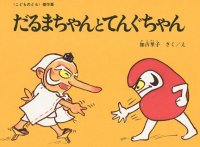 Daruma playing "ken" (paper, rock, scissors) with a Tengu. The Tengu is a type of GORYO, or vengeful spirit. Photo this J-book. a god of the placenta and a controller of human destinies, and finally an epidemic deity and a god of fortune.” <end quote> For more on the monkey and Daruma association, see below. For more in general about the color red, see The Color Red in Japanese Mythology.
|
|
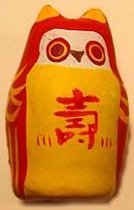
|
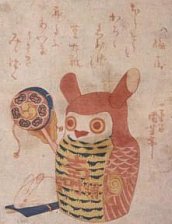
|
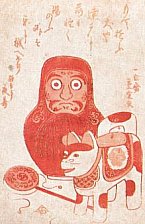
|
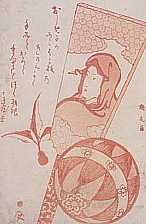
|
|
Owl icons were used in the Edo era to ward off smallpox. Long life 壽 is written on owl’s chest.
Photo GABI GREVE
|
Owl & Toy images were
used to ward off smallpox.
By Utagawa Kuniyoshi
歌川国芳 (1798-1861)
Photo Yamamoto Museum
|
Daruma, Dog, & Toy Drum. Red prints, like this, were used as talimans to protect kids against smallpox.
Photo J-source
|
Red print for girls
赤い羽子板 akai hago-ita.
Here Daruma is female.
By Utagawa Kuniyoshi ??
Photo GABI GREVE
|
|
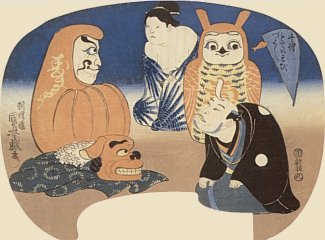
|
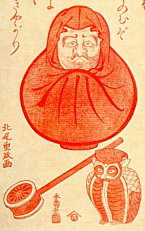
|

|
|
Fan Print by Utagawa Kuniyoshi (1798-1861). From series entitled Toys with Actor's Expressions (Sono omokage teasobi zukushi). Date 1842. A lion's mask, a Daruma doll, a female doll with bare shoulders, an owl, and a male doll playing with a piece of paper (fukigami). Date 1842. Photo Kuniyoshi Project. For full description, see Universität Wien (English)
|
Red-colored print with Daruma, owl, and toy drum. Used as taliman to
ward off smallpox.
Photo Prints of Japan
|
Closeup
of the Owl
Photo
Prints of Japan
|
|
KEYWORDS
- Hōsō-e (Hoso-e) 疱瘡絵. Printed images (usually red in color) to protect children from smallpox (Hōsō 疱瘡). Also known as Aka-e 赤絵 (literally "red prints"), for the smallpox deity was said to like the color red. HŌSŌ 疱瘡 is the Japanese word for smallpox, while E 絵 is the Japanese term for painting, picture, or image. Hōsō Kami 疱瘡神 (or hōsōgami) is the Japanese god of smallpox, who first appears in the Nikon Shoki (日本書紀, approx. 720 AD). The disease, however, reached Japan much earlier, around the time of Buddhism’s introduction (circa 550 AD). The disease was very dangerous. If the ill person’s skin turned purple, it was considered serious. But if the skin turned red, it was believed the patient would recover.
- Mimizuku みみずく (Owl), who is often shown together with Daruma in talismanic artwork aimed at warding off smallpox and illness in general.
- Puppy Dog. A lucky charm, considered a symbol of good health in Japan. Usually made of papier-mache 張り子の犬.
RESOURCES ON THIS TOPIC
- Eisai Co. Ltd. Online Museum. Various Hōsō-e “red images” from the Edo Period.
- Faure, Bernard. Scholar of Japanese religion, now at Columbia University. The Patriarch Who Came From the West. Daruma, Smallpox, and the Color Red.
- Fujioka, Mariko 藤岡摩里子. Lost Owl and Laughing Daruma: Toys in Ukiyo-e Woodblock Prints in the Edo Period. Japanese language. 2008. This book features three ukiyo-e works of Utagawa Kuniyoshi 歌川 国芳 (1798-1861) that include the owl.
- Greve, Gabi. Edo Toys and Talismans. Gabi is a longtime Japan resident and site contributor. She is the Deva of Daruma, the Bodhisattva of Bodhidharma, and a Daruma Aficionado Par Excellence. She also runs the Daruma Museum Japan.
- Prints of Japan says “Aka-e 赤絵 (literally "red prints"). Also referred to as hōsō-e 疱瘡絵 or smallpox pictures. Often sold door-to-door by Japanese monkey trainers in the 18th century as talismans against smallpox. This is interesting because monkeys were often kept in stables to ward off horse diseases (see Monkeys & Horses below). It is even said that samurai who wanted to spy on their enemy's camp would pose as monkey trainers just to gain admittance. [Such evil-expelling prints were] originally used in China, then adopted in Japan, where they often featured images of Shōki 鍾馗, the Demon Queller. Shōki’s image was commonly shown on the 5th day of the 5th month (or Boy's Day) as a similar talisman for warding off evil.”
- Rotermund, Hartmut. Demonic Affliction or Contagious Disease? Changing Perceptions of Smallpox in the Late Edo Period. Japanese Journal of Religious Studies 2001 28/3–4.
- Schumacher, Mark. Color Red in Japanese Mythology (this site). 2005.
- Yamamoto Museum in Unzen City 雲仙市, Nagasaki Pref. Japanese Language. Four red images plus descriptions of 疱瘡絵 and 赤絵.

|
|
|
Daruma’s Evolution into a Phallic Talisman
Example of Daruma art lending itself to phallic symbolism (progression from left to right).
|
|
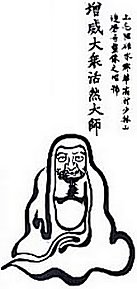
|
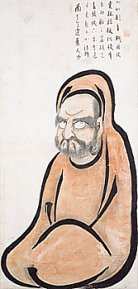
|
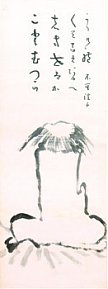
|
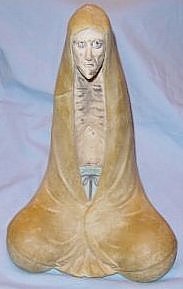
|
|
Daruma-ji Temple
少林山達磨寺 (Gunma)
Shinetsu 心越, founder of this temple, reportedly began a custom in the 17C of giving farmers pictures of Bodhidharma as a talisman to ward off evil.
|
Tokeiji Temple
東慶寺 (Kamakura)
By Hakuin Ekaku
白隠慧鶴 1685-1768.
See above link for inscription.
|
Tokeiji Temple
東慶寺 (Kamakura)
By Shaku Sōen
釈宗演 1860-1919. Menpeki (Wall Gazing) Daruma
from the rear. 
|
Gabi Greve
Phallic Daruma
12 inches high.
Very special design.
|
As shown above, Daruma artwork lent itself easily to phallic symbolism without any need for folkloric references. Yet, there is little doubt that Daruma’s metamorphosis into the male organ was pushed along by the widespread use in the late Edo era of the armless and legless Daruma tumbler doll talisman against smallpox. When knocked on its side, the doll pops back to the upright position and therefore symbolizes (1) a speedy recovery from illness, akin to “getting back on one’s feet;” or (2) resilience, undaunted spirit, and determination. Such imagery can be easily employed to describe the down-up, soft-hard nature of the male sexual organ. With only a little imagination, one can easily understand why Daruma paintings and talismanic representations fell naturally under the same phallic sway. Says scholar Bernard Faure: “Until the Meiji period, phallic representations of Daruma in stone or papier mache were sold. The name ‘Daruma’ was also a nickname given in the Edo period to prostitutes, perhaps because, like the doll, these specialists of tumble could raise the energy of their customers........ There is also in Zen iconography a representation of the ’erect Bodhidharma.’ The sexual symbolism is played out in the ukiyoe [woodblock prints], where Daruma appears as woman — a courtesan, or a transvestite Daruma and Okame. A representation in which one sees him in the company of two prostitutes — male and female — on a boat made from a reeds associates the sexual motif with that of the crossing of the Yangzi River............[also] as Hartmut Rotermund REFERENCES:
Rotermund, Hartmut. O. Hosogami ou la petite verole aisement. Paris: Maisonneuve et Larose. 1991. Also see
Demonic Affliction or Contagious Disease? Changing Perceptions of Smallpox in the Late Edo Period. by Hartmut. O. Rotermund, Japanese Journal of Religious Studies 2001 28/3?4. 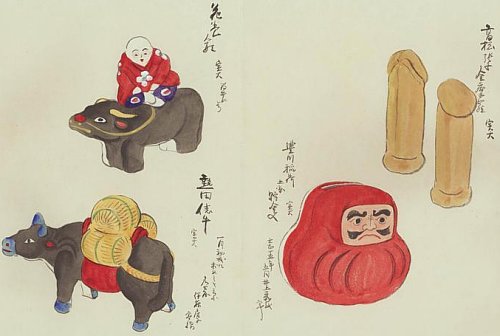
Dated to 1926 (Aichi Prefecture). Photo: Ningyo-do Bunko 人魚洞文庫 Database (Osaka)
Daruma Tumbler Doll 達磨起上り、Wealth (Rice Bales) 貯金玉・俵・花巻人形、Cows 牛、Child 子供、Male Organs 陰茎

|
|
|
Daruma as a Woman
Pictorial example of Daruma (male) becoming Damura (female).
|
|
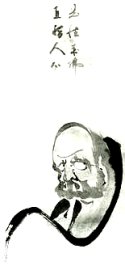
|

|
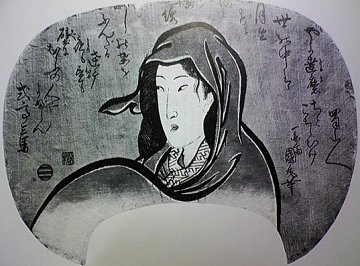
|
|
By Hakuin Ekaku
白隠慧鶴 (1685-1768). Inscription: Zen points directly to the human mind. See into your nature and become Buddha. Sumi on paper.
64.5 cm x 27.6 cm
Photo Israel Museum
|
By Yamaoka Tesshū 山岡 鉄舟 (1836-1888), the famous Meiji-era swordsman and calligrapher.
Photo:
Japanese Martial
Arts Society
|
Female Daruma, Fan Art 「女達磨」
Victoria & Albert Museum (UK)
ヴィクトリア&アルバート博物館蔵
by Utagawa Kunimaru 歌川 国丸 (1793 - 1829)
江戸 時代中期の浮世絵師
Photo this J-site.
|
|
In many ways, Daruma was the perfect candidate for female depictions and sexual symbolism.
The most obvious indicators are mentioned below <most come from Bernard Faure>:
- In Tibet, China, and Japan, Daruma is said to be a manifestation of Avalokitêśvara (Jp. = Kannon), commonly known today as the Goddess of Mercy. Kannon was originally considered male in the Buddhist traditions of China and Japan, but starting around the 11th - 12th centuries, Kannon was commonly portrayed as female in China (less so in Japan). One of Kannon’s female manifestations is Gyoran Kannon 魚籃観音 (lit. = Kannon with Fish Basket; Chn. = Yúlan Guānyīn), who in various old legends uses the bait of sexuality or promise of marriage to enlighten men. In the end, however, she remains a virgin. Her imagery as seductress was utilized as a didactic tool to help men overcome their sexual lust and break free of sexual desire.
- Daruma’s nine years of meditation facing a cave wall at Shaolin Temple in China is analogous to nine months within the womb.
- Daruma’s red robe, usually pulled over his head, symbolizes the placenta. Bernard Faure calls this “putting on the caul” (the caul is the embryonic membrane covering the head at birth).
- The popular red-colored Daruma tumbler doll (which, when knocked on its side, pops back to the upright position) is akin to the penis (which falls and rises) and also to the resilience of the prostitute (who lies down and soon gets back up).
- In Japan, the color red is not only the color of illness, but also the color of fertility and childbirth.
- Daruma’s role in protecting children against smallpox symbolizes rebirth and/or recovery)
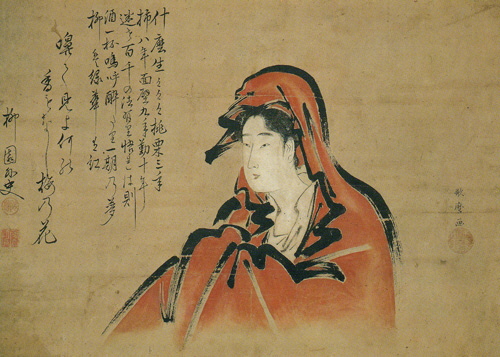
Female Daruma 女達磨図 by Kitagawa Utamaru 喜多川 歌麿 (1753-1806)
Tochigi Kuranomachi Museum of Art 栃木蔵の街美術館. Photo this J-site
|
|
|
Daruma and Courtesans, Daruma and Prostitutes
|
|

|
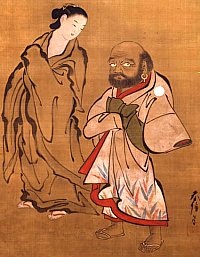
Daruma Dressed as Harlot
Daruma Yūjo Isouzu 達磨遊女異装図
by Takeda Harunobu 竹田春信
(thrived mid Edo era).
Etsuko & Joe Price Collection.
Photo This J-Site.
|
|
 The Japanese themselves generally credit artist Hanabusa Icchō 英一蝶 達磨 (1652-1724) with first introducing the theme of Daruma and Courtesan. Since then, Daruma has served as a popular source of parody, laughter, and ribaldry, with Edo-era artists portraying him alongside courtesans, or dressed in the clothes of a woman, or manifested as a female, or shown only as a minor element in the painting (e.g., gazing desirously at the woman in the main scene). The Japanese themselves generally credit artist Hanabusa Icchō 英一蝶 達磨 (1652-1724) with first introducing the theme of Daruma and Courtesan. Since then, Daruma has served as a popular source of parody, laughter, and ribaldry, with Edo-era artists portraying him alongside courtesans, or dressed in the clothes of a woman, or manifested as a female, or shown only as a minor element in the painting (e.g., gazing desirously at the woman in the main scene).
Writes Daruma scholar H. Neill McFarland: “A common theme is the pairing of Daruma with a woman. Typically in the woodblock prints, the woman is identified as a courtesan. Young, beautiful and gorgeously attired, she is demure, but also emotionless -- perhaps, one could say, as calm and self-sufficient as a Zen monk. Daruma, on the other hand, traditionally so stolid, here is the epitome of discomfiture. His glaring eyes, otherwise symbols of outward alertness and inner awareness, now bug at the unaccustomed distraction and attraction of the female presence. His whole demeanor suggests rather incriminatingly that, for all his vaunted self-discipline, this most austere personage must contend with a residue of human passion. During the Edo period, the frustration of living under repressive conditions pushed frivolous tendencies to the level of social satire, and it also contributed to an obsessive interest in amorous liaisons with the enchanting denizens of the pleasure quaters. It is not surprising that Daruma, seemingly so in control, became an object of parody and ribaldry.” <end quote>
Keywords: Oiran 花魁 (courtesan), Yūjo (Yujo) 遊女 (harlot, prostitute), Geisha 芸者. |
|
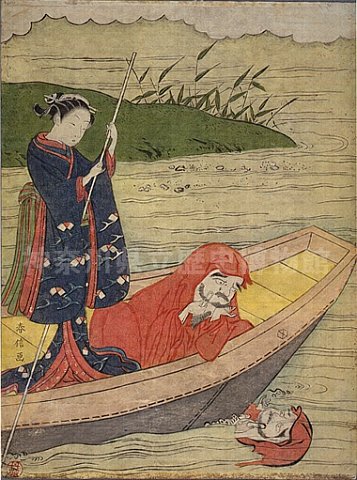
Daruma and Courtesan 「達磨と遊女図」
By Suzuki Harunobu 鈴木晴信 (1743 - 1807)
Says Daruma scholar H. Neill McFarland: "In an uncharacteristic display of vanity, Daruma gazes at his reflection in the water and daintly tweezes some stray hairs from his beard, while the young woman poles the boat." Photo from the Kanagawa Prefectural Museum of Cultural History.
|
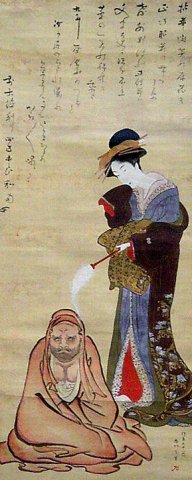
Daruma and Courtesan 「達磨と遊女図」
by Katsukawa Shunkō 勝川春好 1743-1812
Daruma staring at a cave wall,
being tempted by a coutesan.
Photo This J-Site.
|
|
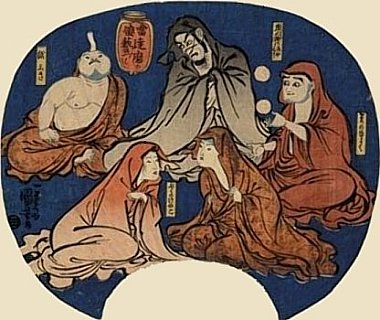
By Utagawa Kuniyoshi 歌川国芳 (1798-1861).
Date 1842. Artistic Performances of Daruma Monks (Tōsei Daruma no gei zukushi). Five variations of Daruma -- two squabbling women, one juggler, a male playing with a piece of paper (fukigami), and the actor Ichikawa Danjūrō VII as the aged Daruma, whose nose was so long that a thread, wound around his nose and one ear, would actually hold.
Photo: Kuniyoshi Project.
|
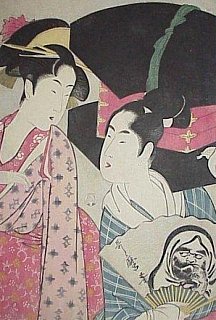
By Kitagawa Utamaro 喜多川歌麿 1753-1806. A seller of fan-papers (jigami-uri 地紙売り) and two young beauties from an untitled series of eight prints published around 1797 by Tsuruya Kiemon 鶴屋喜右衛門. The idealised itinerant merchant has black fan-shaped lacquer boxes perched on his shoulder. In his hand he holds a fan with an image of Daruma eyeing the couple. Photo & text from Japanese Prints (London)
|
|
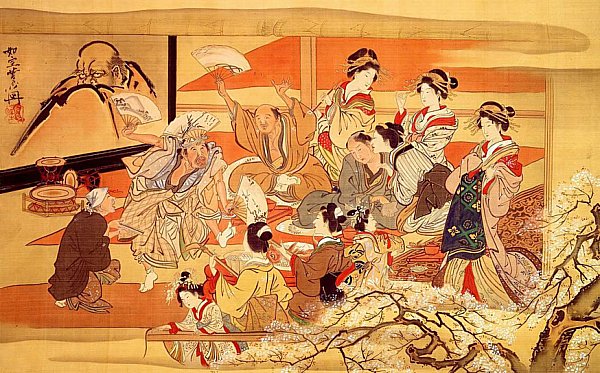
Daruma Watching the Action at Cherry Blossom Viewing and Sake Drinking Party 楼酒宴図
By Kawanabe Kyōsai 河鍋暁斎 (1831-1889). Photo from Etsuko & Joe Price Collection
|
|
|
Daruma as a Woman
Pictorial example of Daruma becoming female in the popular river-crossing scene.
|
|
See Daruma Crossing the Yangtsu River for details on this well-known episode in Daruma’s life, which did not appear in texts involving Daruma until the 12th century.
|
|

|
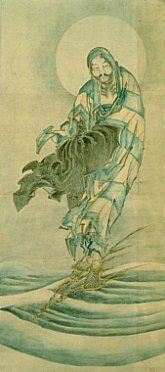
|

|
|
By Kawanabe Kyōsai 河鍋暁斎 (1831–1889). Royō 芦葉達磨. Daruma Crossing the
River on a Reed.
Photo from the
Muian Collection (J-Site)
|
By Katsushika Hokusai
葛飾北斎 (1760-1849).
Daruma Crossing the River on a Reed. Hanging scroll; ink
and color on paper.
H 104.2 cm x 43.2 cm.
Museum of Fine Arts Boston
|
By Suzuki Harunobu 鈴木晴信 (1743 - 1807).
Parody of Bodhidharma (Daruma)
Crossing the River on a Reed.
Woodblock print, ink and color on paper.
H 28.8 cm x W 21.6cm.
Museum of Fine Arts (Boston)
|
|
|
Daruma’s Various Female Doll Forms
|
|
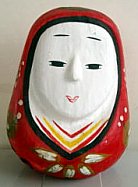
|
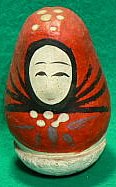
|
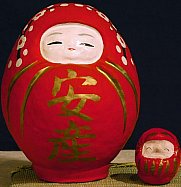
|
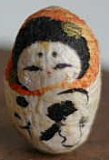
|
|
Onna Daruma 女達磨. Female Daruma.
Photo this J-Site.
|
Onna Daruma 女達磨. Female Daruma.
Photo this J-Site.
|
Anzan Daruma 安産ダルマ
Easy labor, safe delivery.
Photo this E-Site.
|
Mayu Daruma 繭達磨
Diety of Sericulture.
Photo this J-Site.
|
|
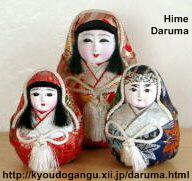  Some Japanese localities have female dolls called Hime Daruma 姫達磨 (meaning "princess daruma") or Onna Daruma 女達磨 (meaning “female Daruma). Such dolls are purchased to protect babies, or bought by the parents of a baby girl as a talisman to pray for their daughter’s healthy growth. Says Gabi Greve: “We also have the story of a courtesan who commented about Daruma ‘Well, he was sitting in quiet meditation for nine years, but we have to sit and suffer here in the Noisy Pleasure Quarters for more than ten years!’ The painter Hanabusa Icchō 英一蝶 達磨 (1652-1724) is generally credited with making a picture of the courtesan that became the model for Princess Daruma Dolls.” <end quote> Some Japanese localities have female dolls called Hime Daruma 姫達磨 (meaning "princess daruma") or Onna Daruma 女達磨 (meaning “female Daruma). Such dolls are purchased to protect babies, or bought by the parents of a baby girl as a talisman to pray for their daughter’s healthy growth. Says Gabi Greve: “We also have the story of a courtesan who commented about Daruma ‘Well, he was sitting in quiet meditation for nine years, but we have to sit and suffer here in the Noisy Pleasure Quarters for more than ten years!’ The painter Hanabusa Icchō 英一蝶 達磨 (1652-1724) is generally credited with making a picture of the courtesan that became the model for Princess Daruma Dolls.” <end quote>
|
|
 |
|
Ippitsu Daruma 一筆達磨
Daruma drawings created with a "single brush stroke" or quickly outlined in broad strokes.
|
|
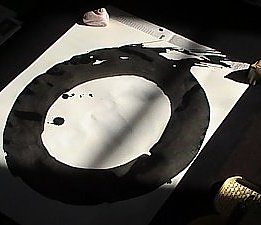
|
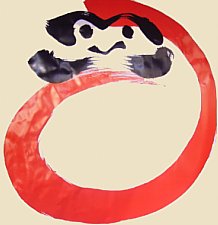
|
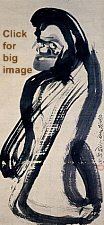
|
|
Ensō (Enso) 円相
By modern artist Afaq Saleem
See below note about Ensō.
|
From poster advertising the March 2011 Daruma Fair at Jindaiji Temple
Photo: This J-site
|
By Soga Shōhaku 曾我蕭白 (1730-1781). Photo
|
|
Ensō (Enso) 円相. Ensō in Japanese means "circle." In Japan's Zen sects, the circle symbolizes enlightenment and perfection. It is a common motiff used by artists to express "unhindered movement" of brush and artistic spirit, and typically painted with a single stroke of the brush. For three Ippitsu Daruma drawings by Nantembō 南天棒 (1839-1925), see Bachmann-Eckenstein Exhibit 1991.

|
|
|
Daruma Dolls & Daruma Tumbler Dolls
|
|

|
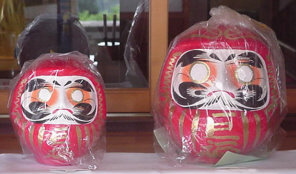
Daruma dolls, still in their protective plastic wrapping
|
|
 The red circular dolls one sees everywhere in modern Japan were first developed in the 16th century and commonly used in the Edo period (1615-1868) as a charm to ward off smallpox <source JAANUS>. In those days, the smallpox god was said to like the color red, so the common folk tried to please the deity in the hopes of averting illness or being granted a speedy recovery. Smallpox disappeared after vaccination was introduced to Japan in the Meiji period (1868-1912), but the bright red Daruma dolls remained extremely popular as good-luck charms and today they remain one of Japan’s most popular talismans of good luck. The dolls have no arms or legs because of legend -- during Daruma’s nine long years of meditation in China, his arms and legs reportedly atrophied, shriveled up, and fell off. The dolls are red because that color has long been associated with warding off smallpox and illness (although most Japanese today have forgotten this). The dolls have no eyelids, for Japanese legend says Daruma once fell asleep during meditation, and in anger, he cast them off to prevent sleep from ever again interrupting his meditation. The eyelids fell to the ground and sprouted into China's first green tea plants. The red circular dolls one sees everywhere in modern Japan were first developed in the 16th century and commonly used in the Edo period (1615-1868) as a charm to ward off smallpox <source JAANUS>. In those days, the smallpox god was said to like the color red, so the common folk tried to please the deity in the hopes of averting illness or being granted a speedy recovery. Smallpox disappeared after vaccination was introduced to Japan in the Meiji period (1868-1912), but the bright red Daruma dolls remained extremely popular as good-luck charms and today they remain one of Japan’s most popular talismans of good luck. The dolls have no arms or legs because of legend -- during Daruma’s nine long years of meditation in China, his arms and legs reportedly atrophied, shriveled up, and fell off. The dolls are red because that color has long been associated with warding off smallpox and illness (although most Japanese today have forgotten this). The dolls have no eyelids, for Japanese legend says Daruma once fell asleep during meditation, and in anger, he cast them off to prevent sleep from ever again interrupting his meditation. The eyelids fell to the ground and sprouted into China's first green tea plants.
Sold at temple festivals and fairs, Daruma dolls are typically made of papier mache and depict Daruma in meditation. The doll comes in many sizes -- sometimes larger than a basketball. While most Daruma dolls are male, some Japanese localities have female dolls called Hime Daruma 姫達磨 or 媛達磨 (meaning "princess daruma") or Onna Daruma 女達磨 (meaning “female Daruma). In Kanazawa, for instance, Hime Daruma figurines are used as amulets for protecting babies <Frederic>, while nationwide, the parents of a baby girl generally purchase a Hime Daruma doll as a talisman to pray for their daughter’s healthy growth <Greve>. Daruma dolls are also called “tumbler dolls” (okiagari koboshi 起き上がり小法師), for when knocked on their side, they pop back to the upright position. Such dolls are reportedly linked to a Japanese proverb associated with Daruma -- Nana Korobi Yaoki 七転び八起き(if you fall down seven times, get up eight). Its meaning? Resilience, undaunted spirit, and determination are the recipe of success. If at first you don’t succeed, try try again. In another tradition involving Daruma, there is a Japanese saying "to have good luck" (Me ga deta 目が出た; lit. = eyes come out). According to Daruma afficiado Gabi Greve: “This means to have the higher number in a game of dice, and is itself a play on the word for ’congratulations’ (ME-DE-TAI), so the eyes are important symbols of luck and winning. There are some Daruma figures, especially little talismans you can buy at temples or shrines, where the eyes pop out to invoke this saying.”

 Daruma Eye-Painting Custom Daruma Eye-Painting Custom
Daruma Kaigan / Kaigen 達磨開眼
Kaigan Shiki 開眼式, Eye-Painting Cermony
Daruma dolls are sold without the eyes painted in. At New Year time, before getting married, and at other important junctures in life, many Japanese individuals buy a Daruma doll, make a wish, paint in the left eye, then put the doll on their home altar or bookshelf. If, during the year, they are able to achieve their goal, they paint in the right eye while giving thanks. Many politicians, at the beginning of an election period, will buy a Daruma doll, paint in one eye, and then, if they win the election, paint in the other eye at a victory ceremony in front of their supporters. When your wish comes true, and the second eye is painted in, this is sometimes called “both eyes pop open” (Me ga Deru 芽が出る or 目が出る or Me ga Deta 目が出た or Ryōme ga aku 両目が開く), a Japanese phrase meaning a winning roll of the dice (the eyes of the dice are called ME芽), a victory, a success, or the attainment of a goal or wish. At year end, it is customary for people to take their old Daruma dolls to a local temple, where they are burned in a big bonfire along with thousands of other Daruma talismans in a ceremony known as Daruma Kuyō 達磨供養. At such events, it is customary to purchase a new doll for the coming year and start the cycle once again.
According to Daruma scholar Kidō Chūtarō (Kido Chutaro) 木戸忠太郎, the selling of Daruma dolls with eyes began around 1764, a time when many children were afflicted with smallpox, which is especially dangerous for the eyes. A Daruma was then used at a talisman to protect from this eye affliction. Since a Daruma with no eyes painted has no special facial expression, the dealers soon sold Daruma dolls with no pupils painted and urged the customers to paint one pupil first and the second after they got better. This custom may have started around 1772. But with the vaccination against smallpox in the beginning of the Meiji period the use of eyeless Daruma as protector for the eyes also disappeared, or rather it changed to other departments of good luck in life.
The Daruma eye-painting custom is probably based on a much earlier Buddhist ritual called Kaigan Kuyō 開眼供養 (lit. eye-opening ceremony), in which a newly made Buddhist statue was consecrated by an officiating priest who would paint in the pupils of the statue’s eyes, at which time (it is thought) the essence or soul of the deity would enter the statue. The first Kaigan Kuyō (eye-opening) ceremony in Japan occurred in 752 AD, when the officiating priest painted in the eyes of the Great Buddha of Nara.
In modern times, there are numerous eye-painting ceremonies for Daruma dolls. Jindaiji Temple 深大寺 in Tokyo, for example, holds an annual Darama Fair each year on March 3 and 4. People buy a Daruma doll, and pay a small sum to have a temple monk paint in the blank left eye with the Sanskrit sound for “A,” which signifies that a wish as been made and initiated. If your wish is fulfilled, you should paint in the other eye with the Sanskrit sound for “N,” which signifies that a wish has been granted and completed. “A” is the first sound in the Japanese alphabet, while "N" (pronounced “un” ) is the last, so the combination symbolically represents all possible outcomes (from alpha to omega) in the cosmic dance of existence. The first and last sounds produced by the mouth are “A” (mouth open) and “N” (mouth closed). The ancient Sanskrit holy word AHAM (ON in Japan) encapsulates this very concept. The two fierce statues guarding the entrance gate at most Japanese temples (the Niō 仁王) are another representation of this concept. The Niō statue with open-mouth is called Agyō, who utters the sound "ah." His closed-mouth partner is called Ungyō, who sounds "un." The same is true for the two lions who stand guard outside most Japanese shrines -- one is commonly depicted with mouth open, the other closed. These two cosmic sounds (originating in India) represent beginning and end, birth and death, yin and yang, male and female, etc. The Daruma eye-opening ceremony at Jindaiji Temple symbolizes wish asked (begun) and wish granted (completed). The ceremony is thus a clever modern way to emulate much earlier Buddhist tradition. For more on the eye-opening ceremony at Jindaiji Temple, please see story in Timeout Japan Tokyo (March 3, 2010).
The Daruma eye-painting custom, nonetheless, may have sprung from an entirely mundane source. Muses site contributor Gabi Greve (manager of the Daruma Museum Japan): “When you paint eyes on a Daruma doll, it takes on some facial expression. If you are not a good painter, it [the doll] might look awkward or evil. So if you are a merchant selling Daruma dolls, it is a lot easier not to paint in the pupils but rather leave that up to the customer, who then takes the blame or credit for the resulting facial expression.”

Daruma Kuyō (Kuyo) 達磨供養
Daruma Memorial Service <below paragraph from Tokyo Metropolitan Government> "Daruma Kuyō" is an annual event held since 1954 at Nishi-Arai Daishi 西新井大師 Temple (Tokyo), an old famous temple, the origin of which dates back to the year of 826. Daruma is a votive symbol for people wishing for the well-being of the family and flourishing business. People bring their Daruma figures once a year (on Feb. 3) to the temple, express gratitude to them, and buy new ones for the next one year. The numbers of old Daruma figures are burnt together in the temple. The ceremony of "Daruma Kuyō" is full of solemnity starting with the entrance of Buddhist monks in the style of mountain priest blowing a conch-shell horn, followed by monks in Buddhism garment, into the garden of the Komyo-den where old Daruma figures are gathered. Then the tens of thousands Daruma figures are lighted in the sounds of sutra reading by the monks. On this same day, the bean-scattering ceremony celebrating the coming of spring is held in the Hon-den. <end quote>

 Where Are Daruma Dolls Made? Where Are Daruma Dolls Made?
Text & Photo Courtesy Japan Atlas: Traditional Crafts (once there, click #5 Takasaki Daruma). “The making of Daruma dolls in Takasaki City 高崎市 (Gunma Prefecture) began in the late 17th century as a relief measure for farmers who were suffering from famine. The story is that the Shōrinzan Daruma-ji Temple 少林山達磨寺 in Takasaki instructed farm households to make dolls from papier mache as a way of earning extra income. These days nearly 100 households annually make about 1.6 million daruma dolls, accounting for about 80% of all daruma dolls made in Japan. Every year on the 6th and 7th of January, a Daruma Market (Daruma Ichi 達磨市) is held in the precincts of Shōrinzan Daruma-ji Temple, and hundreds of thousands of people visit it.” <end quote>
Fuku Daruma 福達磨 (Lucky Daruma)
Says the official site of the Shōrinzan Daruma-ji Temple in Takisaki: "The Fuku Daruma 福達磨 or Engi Daruma 縁起達磨 [Lucky Daruma Dolls] originated here at the Shōrinzan Darumajii. Shinetsu 心越, the founder of this temple, began a custom of giving the farmers pictures of Bodhidharma, which he would draw with a single brushstroke, as a talisman to ward off evil during the year. Later, during a famine in the Tenmei period 天明 (1781-1789), Tōgaku 東嶽, the ninth priest, made a wooden effigy of Bodhidharma based on the pictures. He taught the farmers how to make these 'Daruma dolls' so that they would have something to sell to tide them over in bad years.” <end quote>
Daruma Ichi 達磨市 (Daruma Fairs)
Daruma Fairs (selling thousands of Daruma dolls ranging in size from 6 cm. to 75 cm.) are held in many Japanese localities in modern times. Three Daruma Fairs are particularly popular and known as the Three Great Daruma Fairs of Japan (Nihon Sandai Daruma Ichi 日本三大だるま市と呼ばれている). They are held at:
- Shōrinzan Daruma-ji Temple 少林山達磨寺 (Takisaki City, Gunma), Jan. 6 & 7 each year
- Jindaiji Temple 深大寺 (Tokyo), March 3 & 4 each year
- Imaisan Myōhōji Temple 今井山妙法寺 (Fuji City, Shizuoka), 7th through 9th of Lunar New Year

|
|
|
DARUMA’S OTHER ASSOCIATIONS
HORSES, MONKEYS, SHŌTOKU TAISHI, SERICULTURE
Topics Requiring Further Research
|
|

|
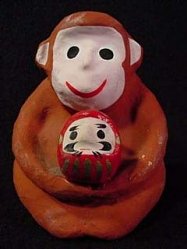
Monkey holding red Daruma doll.
Double Good Luck, Circa 1960.
Modern, courtesy eBay
|
|
 Monkeys, Horses, and Daruma Monkeys, Horses, and Daruma
- Daruma’s association with monkeys and horses is nebulous and convoluted. Let us begin with the monkey and horse motif. In Chinese and Japanese artwork, the monkey is often shown riding the horse. This symbolism stems from the 16th-century Chinese story Journey to the West, in which the Jade Emperor appoints the Monkey to the post of “Protector of Horses” to pacify the monkey’s desire for power and recognition. The next link involves Prince Shōtoku Taishi (574 - 622 AD), the first great patron of Buddhism in Japan, who according to legend was born in a stable -- the prince, by the way, is known by many names in Japan. Two of his names are Umayado 厩戸皇子 or Umayado no Ōji 厩戸皇子王子 (Prince of the Stable Door). When the prince was born, Bodhidharma (Daruma) supposedly manifested himself as a horse and neighed three times. <source Kidō Chūtarō, Ko Daruma Shū 小達磨集, 1977, Page 526>.
- The monkey and Daruma share other associations. Red-colored talismans depicting Daruma were used in the Edo period as talismans to ward off sickness and evil. Let us recall that the god of smallpox was said to like the color red, and red offerings were thus thought to pacify the deity. The monkey is also considered a talisman against sickness and evil, as well as the patron of fertility, safe childbirth, and harmonious marriage at some of Japan’s 3,800 Hie Jinja shrines 日吉神社. These shrines are often dedicated to Sannō Gongen 山王権現 (lit. = mountain king avatar), the central deity of Japan's Tendai Shintō-Buddhist multiplex on Mt. Hiei (Shiga Prefecture, near Kyoto). The monkey is Sannō's Shintō messenger (tsukai 使い) and Buddhist avatar (gongen 権現). Even today, red-colored monkey charms are used in Japan to ward off demons, evil spirits, and sickness (see Migawari-zaru), and monkey statues are often decked in red clothing, the color meant to symbolize fertility and childbirth. The Japanese word for monkey (猿 saru) is a homonym for the Japanese word 去る, which means to "dispel, punch out, push away, beat away," and thus monkeys are thought to dispel evil spirits. Both the monkey and Daruma are associated with warding off illness, with fertility and childbirth, and with the color red.
- The Edo-era distribution of red-colored Daruma prints (Aka-e 赤絵) to ward off smallpox involved both the monkey and the horse. Says Prints of Japan: “Aka-e 赤絵 (red prints) and Hōsō-e 疱瘡絵 (smallpox pictures) were often sold door-to-door by monkey trainers in the 18th century as talismans against smallpox. This is interesting because monkeys were often kept in Japanese stables to ward off horse diseases. It is even said that samurai who wanted to spy on their enemy's camp would pose as monkey trainers just to gain admittance.”
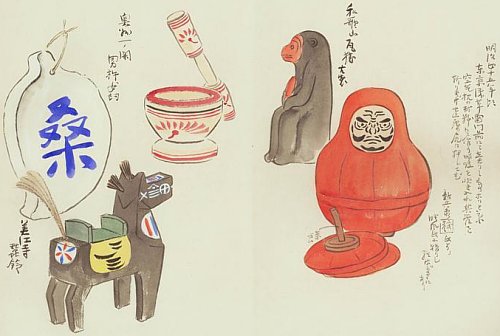
Dated to 1912. Reportedly sold outside the gates of Asakusa Yukimonmae (Tokyo)
Daruma Tumbler Doll, Horse, Monkey, Quernstone, Pestle, Bells
達磨起上り、馬,、猿、臼と杵、鈴 (東京浅草雷門前にて売りしものなりと云ふ)
Photo: Ningyo-do Bunko 人魚洞文庫 Database (Osaka)
Prince Shōtoku Taishi, the Kataoka Beggar, and Daruma
- Japan’s medieval Tendai sect claims that Bodhidharma (after he died but then came back to life; see Sekiri Daruma above) did not return to India but journeyed onward to Japan, where he met Prince Shōtoku Taishi (574 - 622 AD), the first great patron of Buddhism in Japan. Says Bernard Faure: “This version, propagated by the Tendai school, associates Bodhidharma with Shōtoku Taishi, who came himself to be considered an avatar of the Tiantai 天台 master Nányuè Huìsī 南嶽.慧思 (Nanyue Huisi; 517-577; Jp. = Nangaku Eshi). We are told that Shōtoku Taishi one day met a starving beggar at the foot of Mt Kataoka 片岡 (in Nara) and exchanged a poem with him. The strange literate beggar was first identified as an immortal in the Nihon Shoki. His further identification with Bodhidharma rested upon another widespread legend, according to which Huisi had once been Bodhidharma’s disciple. When the two first met on Mount Tiantai, Bodhidharma predicted that they would both meet again in a next life in Japan. This legend grew with the cult of Shōtoku Taishi in the medieval period, and there is still a Daruma Temple at Kataoka, not far from Hōryūji Temple (the monastery intimately connected with the legends of Shōtoku Taishi.”
- Says Gabi Greve: “According to Chinese legend, a few years after the death of Daruma, a Chinese official encountered him in the mountains of Central Asia. Bodhidharma (aka Daruma) was carrying a staff with a single sandal dangling from it. He reportedly told the official he was on his way back to India. When this story made its way back to China, monks decided to open Bodhidharma's tomb. Inside they found only a single sandal. The story somehow continues onward into Japan. One day, Shōtoku was walking near the Japanese village of Kataoka 片岡 (incidentally, very near Hōryūji Temple). During his walk, he met a poor man and gave him a purple cloth. The man died the next day. When Shōtoku made inquires about the man's whereabouts, his assistants reported that the old man had died, whereupon they were ordered to open his grave. Inside they found no body -- just a purple cloth folded nicely. Prince Shōtoku Taishi apparently exclaimed: ’This must have been Daruma, the Founder of Zen.’ The people of that time thought ’How true it is that a sage knoweth a sage. It takes a holy man to recognize another holy man!’ <end quote> NOTE: This story closely mirrors the earlier legend of the One-Shoe Bodhidharma (Sekiri Bodhidharma)
- As mentioned earlier, Japanese legend says Prince Shōtoku Taishi was born in a horse stable, at which time Bodhidharma (Daruma) supposedly manifested himself as a horse and neighed three times. <source Kidō Chūtarō, Ko Daruma Shū 小達磨集, 1977, Page 526>.
Sericulture & Silkworms
- Keywords: silkworms, embryological, komori, incubation, reclusion, gestation (and its relation with an easy childbirth as well)
- Says Bernard Faure: “Another association, at first glance surprising, is that which, in the Kanto region, connects Daruma with silkworms, and transforms him into a talisman for sericulture: the white cocoons have the form of a Daruma, or perhaps one should say that Daruma is cocoon-like. One still sells today as engimono cocoon 縁起物 (good luck cocoon) called Mayu Daruma 繭達磨, on which Daruma features are painted; and this is perhaps related to the fact that, as we will see, both Daruma and the silkworm were symbols of gestation. However, this embryological symbolism, which connects Daruma with the silkworm, refers also perhaps to the practice of the mushi-okuri or ’insect-dispatching.’ It may be a kind of funerary ritual for these creatures, which are sacrificed in large numbers during the spinning process, and of which one may have fear they would become ’resentful spirits.’”
- Says Gabi Greve: “The story of Daruma dolls is also closely linked to the production of silk and raising silkworms. During the first casting off the skin of the silkworm in spring (harugo), the first (left) eye of Daruma is painted in with the wish that they have many good moltings and grow big and fat. When the silkworms start spinning their cocoons in autumn (akigo) the second eye is painted.” Elsewhere, Gabi says: “The Daruma tumbler doll is not always red. In Yamanashi Prefecture, we have a white Daruma as a talisman for the silk industry and the healthy upbringing of children.”
|
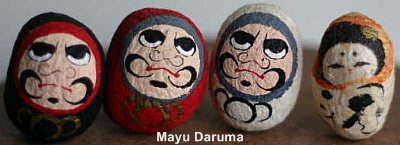
Modern Mayu Daruma 繭達磨. Diety of Sericulture. Photo this J-Site.
Daruma features painted on cocoons.
|
|

Mayu Daruma 繭達磨
Photo this J-Site.
|
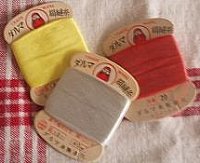
Silk thread in Japan called Daruma Ito,
or Silk Thread Daruma 達磨糸.
|
|
MUST READ, DARUMA’S EVOLUTION IN JAPAN
In his article The Patriarch Who Came From the West. Daruma, Smallpox and the Color Red, the Double Life of a Patriarch, Professor Bernard Faure (Columbia University) explores the relationship between the Bodhidharma legend and the popular image of Daruma in Japan and explains how the austere Chan patriarch eventually became a tumbler doll. This is a “must read” for anyone interested in Daruma. The text which follows is reproduced verbatim from the article.
How did the austere Chan patriarch ever become a tumbler doll? It is a complicated and obscure story. To understand it, we have to unravel many strands that were woven together into one figure. Daruma will thus appear to us successively as:
- a malevolent spirit (goryō 御霊)
- a crossroad deity (dōsojin 道祖神) associated with sexuality
- a placenta god (ena kōjin 胎盤荒神)
- “foreign” epidemic deity (god of Mt. Songshan 嵩山 and Shinra Myōjin 新羅明神)
- a smallpox deity (hōsōgami or hōsōkami 疱瘡神); the Japanese god of smallpox,
- a god of fortune (fukujin 福神)
Other elements contributed to his posthumous success. Let us mention for instance:
- the symbolism of komori, incubation, reclusion, gestation, and its relation with easy childbirth on the one hand, and silkworms and sericulture on the other.
- the color symbolism (red) and spatial (south): fire, exorcism, yang
- the tumbling doll device (with its sexual connotations and its symbolism of rebirth or recovery)
This gradual entertwining of motifs was essentially realized during the medieval period.
READ THE FULL STORY HERE: The Patriarch Who Came From the West. Daruma, Smallpox and the Color Red, the Double Life of a Patriarch, Professor Bernard Faure (Columbia University).
|
|
 |
|
A-to-Z Glossary of Daruma Forms in Japan
Adapted from Daruma Museum Japan, JAANUS, and Others
|

 Akubi Daruma あくび達磨. Yawning Daruma. See photo below. Alternatively, see Google Images. Akubi Daruma あくび達磨. Yawning Daruma. See photo below. Alternatively, see Google Images.
- Anzan Daruma 安産ダルマ. Easy labor, safe delivery. See this J-site.
- Aoi Me no Daruma 青い目の達磨. Blue Eyed Daruma. Daruma is reportedly known as the "Blue-Eyed Barbarian" in some Chinese texts (although I have yet to find any reference). Nonetheless, in Japan, one can find blue-eyed Daruma dolls. See Kite images below.
- A-Un Daruma 阿吽 だるま. The first and last sounds in the Japanese and Sanskrit syllabary; sometimes used to paint in Daruma’s eyes. Details here.
- Bikkuri Gyōten Daruma びっくり仰天 (Daruma looking at the sky; Bikkuri Gyōten is a Japanese expressive meaning sudden dismay, utter surprize, or stupefying).
- Chinsō (or Chinzō) 頂相. Literally “head appearance.” It refers to realistically painted or sculpted portraits of a Zen master's head.
- Daruma no Me-ire 達磨の目入れ. Painting Eyes for Daruma. Also Me-ire no Daruma 目入れの達磨. Details here.
- Daruma Sonsha 達磨尊者. Literally Lord Daruma, Honorable Damura, Venerable Daruma
- Daruma-zō 達磨像. Generic term for Daruma statues or sculpture.
- Daruma-zu 達磨図. Generic term for Daruma paintings and portraits.
- Eka Danpi 慧可断臂. Paintings of Daruma’s disciple Eka Danpi, who cuts off his arm as a sign of his serious desire to study meditation with Daruma.
- Engi Daruma 縁起達磨 or Fuku Daruma 福達磨. Refers to Lucky Daruma Dolls.
- Enmusubi Daruma 縁結びだるま. Says Gabi Greve: "If you are looking for a good spouse, then you must pray to find a partner for life (enmusubi 縁結び). There are many shrines and temples in Japan specializing in this field of human activity and special Daruma dolls sometimes act as a go-between." Also see Fūfu Daruma below (Mr. And Mrs. Daruma).
- Fudō Daruma 不動ダルマ / 不動達磨 or Daruma Fudo 達磨不動. See Gabi Greve for details.
- Fūfu Daruma 夫婦だるま (which can also be read Me-oto Daruma). Mr. And Mrs. Daruma, or Loving Couples. Artwork of the pair is sometimes combined with the famous Takasago Legend 高砂伝説 of a happily married couple. Says Gabi: "A memorial day for happy couples is the second day of the second month (Feb. 2), since FU means TWO. Some hotels and restaurants also give special reductions for couples on the 22nd of any month........You buy them as a pair and keep them to remind you of the endurance and perseverance it takes to make a marriage sucessfull. They are sold at special temples and shrines dedicated to finding and keeping a partner for life." See Gabi Greve for details.
- Fuku Daruma 福達磨 or Engi Daruma 縁起達磨. Refers to Lucky Daruma Dolls.
- Gankake Daruma 願掛け達磨. Daruma to Make a Wish. Also called Menashi (Me-nashi) Daruma 目無し達磨 (Daruma Without Eyes). Details here.
- Hanshinzō 半身像. Bust portraits.
- Hisshō Daruma 必勝だるま. Victory Daruma, used by politicians who win elections. Also known as Senkyo Daruma 選挙だるま (Election Daruma). See Gabi Greve for details.
- Inka 印可. A portrait given by a master to a student as a certificate of the student's attainment of spiritual awareness and as a symbol of the clear and unbroken lineage of a sect. These portraits often include hōgo 法語, or words of religious enlightenment, inscribed by the priest depicted. A portrait done in a realistic and detailed style, together with an inscription, provided the disciple with both the tangible presence and the inspiration of the teaching of his master long after personal relations were severed through parting or death. <source JAANUS>
- Ippitsu Daruma 一筆達磨. Portraits created with a “single stroke of ink or brush,” yielding pictures that are sometimes barely recognizable.
- Keshin 掛真. Portraits hung or placed together with imaginary portraits of Zen patriarchs (zenshū soshizō 禅宗祖師像) in the dharma hall (hattō 法堂) or the main gate (sanmon 三門) of Zen temples for use in conjunction with memorial services. Chinsō sculpture belongs entirely to the keshin category. Keshin portraits were made after the master's death; inscriptions were usually added by close contemporaries. The goal was to symbolize the personal relationship between master and disciple, and artists were encouraged to go beyond the mere physical likeness of the master to capture something of his inner spirit. <source JAANUS>
- Komochi Daruma 子持ダルマ. Fecundity Daruma, to ensure fertility and safe gestation.
- Kotobuki Daruma 寿だるま. Long Life Daruma. Special talismans (dolls) are sold to ensure a long and productive lifespan.
- Matsukawa Daruma 松川達磨. This particular Daruma doll is decorated with numerous symbols of fortune, including a treasure ship, pine/bamboo/plum trees, a carp swimming up a waterfall, the god of luck Ebisu, and the auspicious motif known as “ichi-fuji, ni-taka, san-nasubi” (Mt. Fuji first, hawk second, eggplant third).” According to one widely accepted opinion, this doll is named after Matsukawa Toyonoshin 松川豊之進, a retainer of the Date clan about 170 years ago and the creator of this doll style. Details here.
- Mayu Daruma 繭達磨 or 百達磨 (lit. Cocoon Daruma, One-Hundred Daruma). The embryological symbolism that associates Daruma with silkworms. In this connection, one can purchase silk thread in Japan called Daruma Ito, or Silk Thread Daruma 達磨糸.
- Me Dashi Daruma 目だし達磨 Daruma with Protruding Eyes, or Daruma Whose Eyes Pop Out. Me ga Deru 芽が出る or 目が出る and Me ga Deta 目が出た is a Japanese expression meaning “to have good luck,” but its literal meaning is “eyes coming out.” The phrase originated in the world of Edo-period gambling, for ME 芽 refers to the “eyes” on the dice, while DERU 出る means “coming out, appearing, emanating.” Thus, a winning roll of the dice was met with the exclamation Me ga Deru. Replacing the character ME 芽 (dice eyes) with the homophone ME 目 (human eyes) produces a pun. Thus, small Daruma dolls with eyes that pop out are good-luck talismans in Japan.
- Me-ire no Daruma 目入れの達磨. Painting Eyes for Daruma. Also Daruma no Me-ire 達磨の目入れ. Details here.
- Menashi (Me-Nashi) Daruma 目無しだるま. Daruma Without Eyes (without pupils to be exact). Also called Gankake Daruma 願掛けだるま (Daruma to Make a Wish). Details here.
- Menpeki Daruma 面壁達磨. Wall-Facing or Wall-Gazing Daruma, showing a seated monk facing a cave wall. This refers to the legend of Daruma meditating nine years in a cave in China before reaching enlightenment. Wall gazing is known as hekikan 壁観 (Chn. = biguan, bìguān); wall facing is known as menpeki 面壁 (Chn. = mianbi, miànbì).
- Onna Daruma 女達磨、女だるま. Female Daruma. Details here. Courtesans, Oiran and Daruma, 芸者,花魁とだるま
- Oyako Daruma 親子ダルマ. Parent & Child Daruma. A type of small Daruma doll that comes in two pieces -- a large one representing the parent (usually the mother), and a small one, representing the child. Generally purchased by parents hoping to be blessed with children, and to ensure healthy growth and successful advancement of their child. See this J-site for numerous photos.
- Roundness. Daruma is not only affiliated with piety, but with roundness. Thus a snowman in Japanese is a Snow Daruma (Yuki Daruma 雪達磨), a potbellied stove is called a Daruma Stove 達磨ストーブ, and a barge, wide in girth, is called a Daruma Bune 達磨船.
- Royō Daruma 蘆葉達磨 or 芦葉達磨. Daruma crossing the Yangtze river, depicted standing or floating on reeds. Also sometimes translated at “Daruma on a Rush-Leaf” or “Daruma Crossing the Sea.” It refers to a famous incident from his life, in which he crosses the Yangtze River on his way to north China while balanced on a tiny reed. This event reportedly occured after his unsuccessful meeting with Emperor Wu, after which he journeyed north to the country of Wei. See above (this site) or see Gabi Greve for details.
- Ryū-maki Daruma 龍巻達磨 or 龍巻達磨尊. Image of a dragon coiling around Daruma. See Photo Here.
- Sekiri Daruma 隻履達磨. Literally “One Shoe Daruma.” Such paintings feature Bodhidharma holding a single shoe and derive from the legend that Bodhidharma, after his death and burial on Mt Xioger 熊耳山 (Jp: Yūjizan), came to life again and traveled back to India. A Chinese official returning from India reported he saw Bodhidharma in the mountains carrying a single sandal in his hand. When officials rushed to open Bodhidharma's tomb, they found only the remaining sandal in the otherwise empty grave. <JAANUS>
- Senkyo Daruma 選挙だるま (Election Daruma). Also known as Hisshō Daruma 必勝だるま (Victory Daruma); used by politicians who win elections. See Gabi Greve for details. Many politicians, at the beginning of an election period, will buy a Daruma doll, paint in one eye, and then, if they win the election, paint in the other eye at a victory ceremony in front of their supporters.
- Shōmen 正面. Frontal portraits showing Daruma wrapped in his monk's robe while seated in meditation.
- Yaku Yoke Kuyō 厄除け供養.
Ritual to Ward Off Evil (using Daruma dolls).
- Yokomuki 横向. Three-quarter depictions that only depict Bodhidharma's craggy visage and the sweeping shoulder contour of his robe.
- Yuki Daruma 雪達磨. Literally “Snow Daruma” or “Snowman Daruma.” See above photo. Say Bachmann-Eckenstein (1991): “The inscription is a poem reading ’A Daruma made of piled-up snow. As the days pass by, where has he gone? - No traces of him remain.’ Daruma's legs, according to the legend, withered away during his nine years of meditation. The snowman, since he has no legs, has been called Snow Daruma in Japan. Depicting this subject, Nantembō created one more variant of the Daruma theme. On his representations of the Snow Daruma, Nantembō usually added the poem by Yamaoka Tesshū 山岡鉄舟 (1836-1888). There are several meanings to be found in this poem: Tesshū and Nantembō may have been referring to their concern that the true spirit of Daruma was disappearing in Japan, due to laxity in the training of monks. On the other hand, the vanishing forms and traces may also refer to the state of nirvana, which Daruma achieved by becoming enlightened to his own Buddha nature. (Addiss 1989, 195).” <end quote>
- Zodiac Daruma. Since the Edo period, Daruma was linked to the 12 Animals of the Zodiac, and in this connection serves as the Lord of Destiny, the Deity of One’s Birth Star. As such, Daruma is associated with Myōken Bosatsu (deification of the Pole Star) and other astral deities. Numerous talismans of Daruma along each of the 12 animals can be purchased in modern Japan. See this J-site for examples.
|
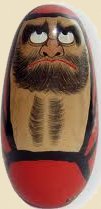
|
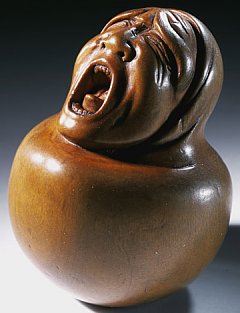
|
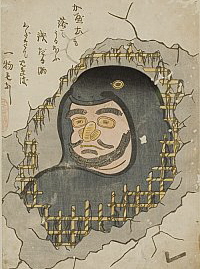
|
|
Kokeshi Daruma
こけし達磨
|
Akubi Daruma あくび達磨
Yawning Daruma
Wood Netsuke, Japan. Circa 1800
Victoria & Albert Museum
Photo from the museum
|
Daruma & Namazu, Woodblock
1855. Namazu = Earthquake Catfish
かべ土も落ちてうる
ほふ銭だるま(仮)
Full image from Rare Books #91.
|
|
NOTES ON LAST TWO PHOTOS
YAWNING DARUMA. Says Gabi Greve: “Opening his mouth real wide he reminds me of Daruma sitting in front of the cave wall in China. Yawning (akubi あくび) is not a socially correct behavior, but to strech your arms and back and take a deep breath brings oxygen to your brain and helps your mind to stay sharp. So it is no wonder Daruma during his long periods of meditation took a good yawn once in a while. And just this moment is captured in some of these humorous statues."
DARUMA AND NAMAZU. This 1855 woodblock print shows Daruma’s head inside the mouth of Namazu 鯰, a giant catfish thought to live deep inside the earth. Its movements are said to cause earthquakes. During the 19th century, Daruma was worshipped as a protector against earthquakes. <Kidō, Chūtarō. Ko Daruma Shū 小達磨集. 1977. Japanese language.> In the painting, Daruma’s nose and eyes are shown as gold coins, while his eyebrows, mustache, and beard are depicted with coils of dark-colored metal coins -- this painting is thus a sober reminder that earthquakes create both winners and losers, have and have nots, survivors and victims, those who stand to gain from the devastation, and those who will suffer from it.
 Other Types of Daruma Other Types of Daruma
|
|
|
|
|
Early Chinese Texts about Bodhidharma
|
|

|
|
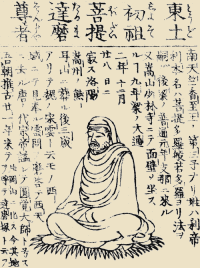
Daruma as depicted in the
Butsuzō-zu-i 仏像図彙
Collected Illustrations of Buddhist Images. Published in 1690 (Genroku 元禄 3). A major Japanese dictionary of Buddhist iconography. Hundreds of pages and drawings, with deities classified into approximately 80 (eighty) categories.
Purchase modern-day reprints of the expanded Meiji-era version here.

Daruma painting with inscription
reading: Kenshō Jōbutsu 見性成佛.
By Hakuin Ekaku 白隠慧鶴 (1685-1768)
(aka Hakuin Zenshi 白隠禅師).
The inscription is part of a famous Chinese
Sung-era 4-line saying attributed to Daruma:
不立文字、 教外別伝、
直指人心、 見性成仏
Jp. = Furyū Monji Kyōge Betsuden
Jp. = Jikishi Jinshin Kenshō Jōbutsu
ENGLISH TRANSLATION ONE
Direct transmission outside the sutras,
directly pointing to the human mind,
seeing self-nature & becoming a Buddha.
ENGLISH TRANSLATION TWO
A special transmission outside scriptures,
No dependence upon words and letters,
Direct pointing to the mind of man,
Seeing into one’s own nature
See this English site for more details.
Photo: Nyosui Assc. 如水会, Shizuka.
|
|
|
|
|
 Most treatises about Bodhidharma are considered apocryphal, as are around ten texts attributed to him. <Broughton> Noted French Japanologist Louis Frederic Most treatises about Bodhidharma are considered apocryphal, as are around ten texts attributed to him. <Broughton> Noted French Japanologist Louis Frederic (1923-1996) calls Bodhidharma a semi-mythical figure. Scholar Bernard Faure even suggests that “Bodhidharma should be interpreted as a textual and religious paradigm and not be reconstructed as a historical figure.” <Faure> (1923-1996) calls Bodhidharma a semi-mythical figure. Scholar Bernard Faure even suggests that “Bodhidharma should be interpreted as a textual and religious paradigm and not be reconstructed as a historical figure.” <Faure>
Early mention of Bodhidharma is found in the Record of the Buddhist Temples of Luoyang 洛陽伽藍記 (Chn. = Luòyáng Qiélán Jì, Jp. =Rakuyō Garan Ki). Written around 547, this text describes Bodhidharma as a very old monk from Central Asia, both a pious and well-traveled foreign pilgrim, who for days sang in praise of the great stupa at Yung-ning monastery [in Luoyang]. <source DDB>
In the Continuation of The Biographies of Eminent Monks 續高僧傳 (Chn. = Xù gāosēng zhuàn, Jp. = Zoku kōsō den), a mid-7th century text written by Daoxuan 道宣 (596–667; Jp. = Dōsen), Bodhidharma is described as a monk from southern India who traveled to China to transmit Mahayana teachings. Daoxuan says Bodhidharma attracted few followers, for his ”wall-gazing” meditation practice was difficult to understand and differed too greatly from the classical Indian dhyāna (meditation) techniques then prevalent in China. Among his students was Huìkě 慧可 (Jp. = Eka), who eventually became the second patriarch. Eka’s story also appears in the Annals of the Transmission of the Dharma Treasure (Chuán fǎbǎojì 傳法寶記; Jp. = Denpō Hōki 伝法宝記), an early 8th-century Chinese text attributed to Dharma-master Dù Fěi 杜朏 (Jp. = Tohi).
Until recently, much of our knowledge about Bodhidharma came from a 1053 AD Chinese document named Record of the Transmission of the Law and Correct Teaching 伝法正宗記 (Chn. = Chuánfǎ Zhèngzōng Jì, Jp. = Denpō Shōshūki). In this and other accounts, Bodhidharma was said to be the son of a Brahmin king in southern India. After achieving enlightenment, he became the 28th successor after Shaka Nyorai (the Historical Buddha), and then traveled to China to transmit Buddhist teachings. <sources: JAANUS and DDB> Information also came from a 10th-century document entitled Record of the Ancestral Hall 祖堂集 (Chin. = Zǔtáng jí, Jp. = Sodō shū), wherein Bodhimarma is described as the third son of a great South Indian king. As Broughton says: “That his father was a king implies that he was of the warrior, and not the priestly, class, which echoes Sakyamuni Buddha’s origins.” <see Broughton’s introduction, page 2>
But, in the early part of the 20th century, a great cache of manuscripts dating to China’s Tang period (618-907) was discovered in Dunghuang, China. Among them was the Treatise on the Two Entrances and Four Practices 二入四行論 (Chn. = Èrrù sìxíng lùn, Jp. = Ninyū shigyō ron), attributed to Bodhidharma (but recorded by his disciple Tanlin). Modern scholars such as John McRae and Jeffrey Broughton see no reason to doubt this attribution. Much has been gleaned from this discovery, including biographical information on Daruma, documents believed to be Bodhidharma’s teachings, and two letters to Huìkě 慧可 (Jp. = Eka), along with the latter’s reply. Both McRae and Broughton provide full English translations with commentary. These matters also appear in the Continuation of The Biographies of Eminent Monks by Daoxuan (Tao Hsuan).
Dharma Jewel Platform Sutra of the Great Master the Sixth Patriarch. Known as the 六祖壇經 (Jp. = Rokuso daishi hōbō dan kyō, Chn. = Liùzǔ dàshī fǎbǎo tán jīng. Attributed to Hui Neng 慧能 (638–713), the Chinese monk who became the sixth patriarch of the Zen sect. Scholars don't fully agree on whether this person even existed, but Hui Neng is commonly considered the author of this text, one of the most influential in Asia’s Zen tradition.” This book was (it is thought) compiled by one of his disciples, who faithfully followed Hui Neng and recorded his teachings. Commonly considered the source of the oft-heard Zen quote attributed to Bodhidharma: 直指人心見性成佛 (Jp. = Jikishi ninshin kenshō jōbutsu), translated as “direct transmission outside the sutras, directly pointing to the human mind, seeing self-nature and attaining Buddhahood.” This quote is also found in the below texts, and it generally means that the direct perception of reality is better than relying on academic studies.
密菴和尚語録 (No. 1999) 0982c07 - 0983a19
廬山蓮宗寶鑑 (No. 1973) 0351a14 - 0351b24
圓悟佛果禪師語録 (No. 1997) 0772b29 - 0773a25
28 Indian Patriarchs (Nijūhasso 二十八祖)
Six Chinese Patriarchs (Zenshu Rokuso 禅宗六相)
 By tradition even today, Daruma is considered the 28th Indian Patriarch of Chan Buddhism, the last in a direct (mind-to-mind) line of transmission from the Historical Buddha known as the 28 Indian Patriarchs (Nijūhasso 二十八祖). Daruma is also considered the first patriarch in a line of transmission known as the Six Chinese Chan Patriarchs (Zenshu Rokuso 禅宗六相). The last of the six, Huìnéng 慧能 (638–713), discontinued the practice of naming a successor, telling all his disciples they were ready to go forth. This ended the tradition in which the outgoing master handed over to his successor the robe & begging bowl (said to have belonged originally to Buddha himself). Zen did not flower in Kamakura until the 13th century, and the Japanese maintain their own local tradition called the twenty-four transmissions of Zen 禪宗二十四流 in Japan. By tradition even today, Daruma is considered the 28th Indian Patriarch of Chan Buddhism, the last in a direct (mind-to-mind) line of transmission from the Historical Buddha known as the 28 Indian Patriarchs (Nijūhasso 二十八祖). Daruma is also considered the first patriarch in a line of transmission known as the Six Chinese Chan Patriarchs (Zenshu Rokuso 禅宗六相). The last of the six, Huìnéng 慧能 (638–713), discontinued the practice of naming a successor, telling all his disciples they were ready to go forth. This ended the tradition in which the outgoing master handed over to his successor the robe & begging bowl (said to have belonged originally to Buddha himself). Zen did not flower in Kamakura until the 13th century, and the Japanese maintain their own local tradition called the twenty-four transmissions of Zen 禪宗二十四流 in Japan.
|
|
DARUMA’S FAMOUS ENCOUNTER WITH CHINA’S EMPEROR
|
|

|
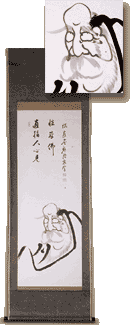
by Matsubara Banryu
(1848-1935)
Zen points directly to the
human heart, see into your
nature and become Buddha!

|
|
 Daruma's famous encounter with Emperor Wu (Chn. = Liáng Wǔdì 梁武帝; Jp. = Ryō Butei) of China’s Liang Dynasty (as presented by the Shambhala Zen Art Gallery). Daruma's famous encounter with Emperor Wu (Chn. = Liáng Wǔdì 梁武帝; Jp. = Ryō Butei) of China’s Liang Dynasty (as presented by the Shambhala Zen Art Gallery).
Says the proud Emperor Wu: "I've constructed dozens of Buddhist temples, supported hundreds of monks and nuns, and sponsored countless religious ceremonies. How great is my merit?"
"No merit at all," Daruma replied bluntly.
"Tell me then," the emperor wanted to know, "What is the first principle of Buddhism?"
"Vast emptiness, nothing holy!" Daruma shot back.
"Who are you?" the thoroughly perplexed emperor demanded.
"I don't know!" Daruma announced, departing as suddenly as he had appeared.
The most common representation of the grand patriarch in Zen art is as a half-body Daruma. By revealing only the upper half of Daruma's body, Zen artists challenged the viewer to look beyond the surface in order to grasp the patriarch's essence. Although seemingly hidden from view, Daruma's core the Buddha-mind can be discerned if one contemplates the painting as an organic whole rather than trying to analyze it from historical, aesthetic, or philosophical perspectives. In half-body Darumas, the face and head are brushed first, then the robe and finally the eyes are dotted in to animate the image. When the painting is complete, an inscription is usually added. In addition to half-body Darumas other common portrayals are side-view Darumas, wall-gazing Darumas, rushleaf Darumas, one-sandal Darumas, and snowman Darumas. When asked how long it took to paint a portrait of Daruma, the great Zen artist Hakuin replied, "Ten minutes and eighty years."
|
|
Brief History of Zen in Japan
|
|

|
ZEN AT A GLANCE. Zen came to prominence in Japan in the Kamakura era thanks to the patronage of the Hōjō 北条 clan, who served as regents of the Kamakura shogunate (military government). A network of state-sponsored Zen temples developed, based on earlier precedents set in China. After the collapse of the Kamakura shogunate, the new Ashikaga rulers created a similar network in Kyoto.
Great Five Zen Temples (Kamakura)
Kamakura Gozan 鎌倉五山
- Kenchō-ji 建長寺 (Hōjō)
- Engaku-ji 円覚寺 (Hōjō)
- Jūfuku-ji 寿福寺 (Hōjō)
- Jōchi-ji 浄智寺 (Hōjō)
- Jōmyōji 浄妙寺 (Ashikaga)
Great Five Zen Temples (Kyoto)
Kyoto Gozan 京都五山
- Tenryū-ji 天龍寺
- Shōkoku-ji 相国寺
- Kennin-ji 建仁寺
- Tōfuku-ji 東福寺
- Manju-ji 万寿寺
Nanzen-ji 南禅寺 served as the
head temple of the Kyoto five.
MAIN ZEN SECTS IN JAPAN (Intro Japan)
- Rinzai Zen 臨済宗 (12th C.)
- Sōtō Zen 曹洞宗 (13th C.)
- Fuke Zen 普化宗 (13th C.)
- Ōbaku Zen 黄檗宗 (17th C.)
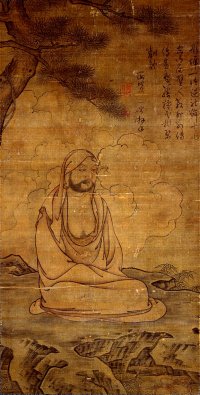
Kamakura Era, 14th C. Ink Painting
Inscription by Issan Ichinei 一山一寧,
a Chinese Rinzai Zen monk of the Yuan dynasty (1247-1317). Photo courtesy
of the Tokyo National Museum
|
|
 Buddhism remained largely confined to the court, aristocracy, and monasteries until the Kamakura Era (1185-1333), when it was popularized by new and reformed Buddhist sects committed to bringing Buddhism to the illiterate commoner. These sects (Pure Land, Zen, and Nichiren) expressed concern for the salvation of the ordinary person, and stressed pure and simple faith over complicated rites and doctrines. For details, see From Court to Commoner Buddhism. Buddhism remained largely confined to the court, aristocracy, and monasteries until the Kamakura Era (1185-1333), when it was popularized by new and reformed Buddhist sects committed to bringing Buddhism to the illiterate commoner. These sects (Pure Land, Zen, and Nichiren) expressed concern for the salvation of the ordinary person, and stressed pure and simple faith over complicated rites and doctrines. For details, see From Court to Commoner Buddhism.
Although Zen Buddhism came to prominence in this period, it had been practiced in China many centuries earlier (where it was known as CHAN Buddhism). The Japanese Zen monk Eisai 栄西 (also read Yōsai; 1141-1215) sparked a great flowering in Zen's popularity from his base in Kamakura, where the Bakufu 幕府 (military government) welcomed the prospect of a new, untarnished religious tradition divorced from the perfumed embroidery of the court and the intellectual elitism of the entrenched monasteries. Eisai had traveled twice to China. On his second visit, he met with Zen master Xuan Huaichang 虛庵懷敞, became his student, and four years later (after receiving certification of his enlightenment from Xuan), Eisai returned to Japan and established its first Zen (Rinzai) temple (Shōfukuji 聖福寺) in Kyushu. Due to various difficulties, Eisai moved to Kamakura, where he spread the Zen doctrine that personal enlightenment is not found in sutras or rituals. Rather, it is found within the self through meditation, restraint, and self-reliance. The various Zen schools attracted the samurai (military class) in particular and infused the arts with new life. Eisai is also credited with introducing tea cultivation to Japan and explaining the medicinal values of drinking tea. Even today, tea is an integral element of the Zen experience in Japan.
Zen's major aesthetic interests were literature, calligraphy, and ink painting. Portrait paintings of prominent monks and people are considered innovations of the Kamakura period, with the Zen sect in particular pursuing this form of expression. This explains why portraitures and paintings of Daruma far outnumber sculptural representations of the Zen patriarch. The contribution of Zen to Japanese culture is profound, and much of what the West admires in Japanese art today can be traced to Zen influences on Japanese architecture, poetry, ceramics, painting, calligraphy, gardening, the tea ceremony, flower arrangement, and other crafts. Details here.
Says Alan Watts in the The Spirit of Zen - A Way of Life, Work and Art in the Far East (Grove Press, 1994, p. 33): “An old man comes over from India, is very rude and abrupt with the Emperor (of China), refuses to see a poor wretch who wants some instruction until he [the wretch] has cut off his arm, and then only says something quite unintelligible. Finally, he is seen walking about with a shoe in his hand. And yet from that time there began something which inspired artists and writers, soldiers and statesmen, something which has influenced the cultures of China and Japan more than any other single factor.

|
|
|
Tea, Zen, and Daruma
|
|

|
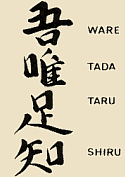
吾唯足知. This Zen saying is found often on water basins in Japan, and commonly translated as: "I am content with what I am (have),” or “Rich is the person who is content with what s/he is,” or "If you learn to be content, you are rich in spirit."
|
|
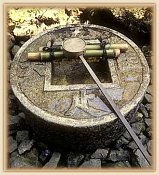
The adjacent inscription is found especially on coin-shaped stone basins (Zenigata Tsukubai 銭型蹲踞) in Japanese tea gardens, perhaps as a reminder to guests to assume a proper state of mental detachment. The Japanese tea ceremony is closely associated with Zen.
|
|
 Zen was introduced to Japan early in the Kamakura Era (1185-1333) and became a favorite of the new Warrior Class (samurai) who had wrested power from the nobility. The primary aim of Zen Buddhsim is personal enlightenment, and according to Daruma, enlightenment cannot be found in books or sutras or in performing rituals. Rather, it is to be found within the self through meditation. Daruma taught that within each of us is the Buddha, and that meditation can help us remember our Buddha nature. But meditation alone is not the answer. We must clear our minds of distracting thoughts, and strive for a mental state free of material concerns, dualistic concepts, and rediscover our lost but true Buddha nature. Zen was introduced to Japan early in the Kamakura Era (1185-1333) and became a favorite of the new Warrior Class (samurai) who had wrested power from the nobility. The primary aim of Zen Buddhsim is personal enlightenment, and according to Daruma, enlightenment cannot be found in books or sutras or in performing rituals. Rather, it is to be found within the self through meditation. Daruma taught that within each of us is the Buddha, and that meditation can help us remember our Buddha nature. But meditation alone is not the answer. We must clear our minds of distracting thoughts, and strive for a mental state free of material concerns, dualistic concepts, and rediscover our lost but true Buddha nature.
The practice of Zen involves long sessions of zazen, or seated meditation, to clear the mind of distractions and to gain penetrating insight. Zen's assimilation into Japanese culture was accompanied by the introduction of green tea, which was used to ward off drowsiness during the lengthy zazen sessions. One Daruma legend says that Daruma brought green tea plants with him when he traveled to China; another says that Daruma plucked off his eyelids in a rage after dozing off during meditation -- the eyelids fell to the ground and sprouted as China's first green tea plants!! To this day an early form of the tea ceremony is carried out in some Zen monasteries in Japan in honor of Daruma.

|
|
|
DARUMA AND THE MARTIAL ARTS
|
|

 Bodhidharma (Jp. = Daruma) is often referred to as the founder of martial arts in both China and Japan (especially Shaolin Kung Fu). At the fabled Shaolin Temple in China, where Daruma is said to have practiced his wall-gazing cave meditation, the temple even today maintains a large rock on which one can see Daruma's shadow -- apparently burned into the rock during Daruma's long years of meditation in front of it. Sō Dōshin (So Doshin) 宗道臣, who founded Japan's Shōrinji Kempō 少林寺拳法 school of martial arts in 1947, says Daruma appeared to him in a dream, and this inspired Dōshin to establish his school. Legends like this have developed largely outside Buddhism, with a stronger connection to Daoist (Taoist) traditions. Nonetheless, Bodhidharma's title as founder of martial arts is still contested among scholars and historians. Please visit below links to learn more. Bodhidharma (Jp. = Daruma) is often referred to as the founder of martial arts in both China and Japan (especially Shaolin Kung Fu). At the fabled Shaolin Temple in China, where Daruma is said to have practiced his wall-gazing cave meditation, the temple even today maintains a large rock on which one can see Daruma's shadow -- apparently burned into the rock during Daruma's long years of meditation in front of it. Sō Dōshin (So Doshin) 宗道臣, who founded Japan's Shōrinji Kempō 少林寺拳法 school of martial arts in 1947, says Daruma appeared to him in a dream, and this inspired Dōshin to establish his school. Legends like this have developed largely outside Buddhism, with a stronger connection to Daoist (Taoist) traditions. Nonetheless, Bodhidharma's title as founder of martial arts is still contested among scholars and historians. Please visit below links to learn more.
- The Bodhisattva Warriors: The Origin, Inner Philosophy, History and Symbolism of the Buddhist Martial Art Within India and China (by Terence Dukes). ISBN: 0877287856. See reviews of book at Amazon link above. Some reviews say the book is fabricated, while others say it is the best research to date to clearly confirm Bodhidharma’s connection with the martial arts.
- BBC - The Way of the Warrior, Bushido and the Warrior Arts
- The Patriarch Who Came from the West (by Bernard Faure)
- Nippon Kempo (The Origins of Kempo). “Though many doubt the authenticity and accuracy of the Bodhidharma legend, there is some evidence to support many aspects of the story. For example, wall paintings that can still be seen at the Shaolin Temple portray dark-colored, perhaps Indian monks among the lighter-skinned Chinese monks practicing or teaching Kempō. This seems to substantiate the belief that Kempō was originally Indian. In addition, the fact that no other temple in China has a history and tradition of Kempō indicates a possible connection with Bodhidharma.”
- KarateBC.org. “Most Western students of Asian martial arts, if they have done any research on the subject at all, will surely have come across references to Bodhidharma. He is known as ’Daruma’ in Japan and as often as not, this Indian Buddhist monk is cited as the prime source for all martial arts styles, or at the very least, for any style which traces its roots back to the fabled Shaolin Temple. However, the question of his contributions to the martial arts and to Zen Buddhism and even of his very existence has been a matter of controversy among historians and martial arts scholars for many years (Spiessbach 1992).
- Wikipedia -- Bodhidharma and Martial Arts. Both the attribution of Shaolin Kung Fu to Bodhidharma and the authenticity of the Yi Jin Jing itself have been discredited by historians.
- Shaolin Temple & Martial Arts (by Frank Bing). Kapiolani Community College, Horizons 2002.
- Shaolin Temple, Kung Fu, Daruma (with photo of shadow rock). Bodhidharma's years of meditation in a cave are said to have left his shadow on this rock, removed from the cave and on display at the Shaolin Temple (China)
- Shorinji Kempo Web Site - History
- Sō Dōshin (Shorinji Kempo founder). Article from Newsfinder, Oct. 10, 2002.
** All above sites were last accessed on April 28, 2011. **

|
|
|
REFERENCES
Below sites were all last accessed on April 28, 2011.
|
|
PRIMARY SOURCES
For an extended discussion of these resources, see Early Chinese Texts above.
- Annals of the Transmission of the Dharma Treasure, 傳法寶記 (Chn. = Chuán fǎbǎojì 傳法寶記; Jp. = Denpō Hōki 伝法宝記), an early 8th-century Chinese text attributed to Dharma-master Dù Fěi 杜朏 (Jp. = Tohi), which includes the story of Eka’s quest to become Bodhidharma’s student.
- Butsuzō-zu-i 仏像図彙, “Collected Illustrations of Buddhist Images.” Published in 1690 (Genroku 元禄 3). Purchase modern-day reprints of the expanded Meiji-period version here (J-site).
- Continuation of The Biographies of Eminent Monks, 續高僧傳 (Chn. = Xù gāosēng zhuàn, Jp. = Zoku kōsō den); mid-7th century text by Daoxuan 道宣 (596–667; Jp. = Dōsen). T 2060.50.425a-707a.
- Dharma Jewel Platform Sutra of the Great Master the Sixth Patriarch, 六祖壇經 or 六祖壇經 (Chn. = Liùzǔ dàshī fǎbǎo tán jīng, Jp. = Rokuso daishi hōbō dan kyō). Attributed to Hui Neng 慧能 (638–713), the sixth Chinese patriarch of the Zen sect. T2008_.48.0345b20.
- Record of the Ancestral Hall, 祖堂集 (Chin. = Zǔtáng jí, Jp. = Sodō shū). 10th-century text discovered in the 20th century; contains records on over 250 people.
- Record of the Buddhist Temples of Luoyang, 洛陽伽藍記 (Chn. = Luòyáng Qiélán Jì, Jp. = Rakuyō Garan Ki). Written in 547 AD by Yang Xuanzhi 楊衒之. T 2092.51.999-1022.
- Record of the Transmission of the Law and Correct Teaching, 傳法正宗記 or 伝法正宗記 (Chn. = Chuánfǎ Zhèngzōng Jì, Jp. = Denpō Shōshūki), mid-11th century text written by Qisong 契嵩 containing biographies of Indian and Chinese patriarchs. T 2078.51.715-76.
- Revision of Baizhang's Pure Rules, 敕修百丈淸規 (Chn. = Chìxiū Bǎizhàng Qīngguī, Jp. = Chokushū Hyakujō Shingi). 14th-century text compiled by Dongyang Dehui 東陽德輝. T 2025.48.1109-1160. This text assigns Bodhidharma (Daruma) with the posthumous title Enkaku Daishi 圓覺大師 (Chn. = Yuánjué Dàshī). See T 2025.48.1118a1. <source: DDB (user name = guest)>
- Treatise on the Attainment of the Bodhisattva Awakening, 成等正覚論 (Jp. = Jōtō Shōgakuron), a medieval document archived at the Kanazawa Bunko in Yokohama. This text presents Daruma as an incarnation of the Bodhisattva Avalokitêśvara (Chn. = Guānyīn, Jp. = Kannon).
- Treatise on the Two Entrances and Four Practices, 二入四行論 (Chn. = Èrrù sìxíng lùn, Jp. = Ninyū shigyō ron), attributed to Bodhidharma (but recorded by his disciple Tanlin). Tang-era document; discovered in Dunhuang Cave 17 in the 20th century.
SECONDARY SOURCES - BOOKS & ARTICLES
- Baroni, Helen J. The Illustrated Encyclopedia of Zen Buddhism. Rosen Publishing (2002)
- Broughton, Jeffrey L. The Bodhidharma Anthology: The Earliest Records of Zen. University of California Press, 1999.
- Clark, Timothy. Prostitute as Bodhisattva: The Eguchi Theme in Ukiyo-e. Impressions 22 (2000), pages 36-53.
- Dumoulin, Heinrich. Zen Buddhism: A History India & China, Vol. 1. World Wisdom (2005). Also see "Early Chinese Zen Reexamined: A Supplement to Zen Buddhism: A History." (1993)
- Faure, Bernard. Bodhidharma as Textual and Religious Paradigm. History of Religions, Vol. 25, No. 3. (Feb., 1986), pp. 187-198. See list of Faure’s many publications.
- Faure, Bernard. The Patriarch Who Came From the West. Daruma, Smallpox and the Color Red, the Double Life of a Patriarch. (year ??)
- Faure, Bernard. The Daruma-shū, Dōgen and Sōtō Zen, Monumenta Nipponica, Vol. 42, No. 1 (Spring, 1987), pp. 25-55.
- Frederic, Louis. Buddhism (Flammarion Iconographic Guides)
 Pages 107-109. Printed in France, ISBN 2-08013-558-9. First published 1995. Pages 107-109. Printed in France, ISBN 2-08013-558-9. First published 1995.
- JAANUS. Japanese Architecture and Art Net Users System.
- Lachman, Charles. Why did the Patriarch Cross the River? The Rushleaf Bodhidharma Reconsidered, Asia Major, vol. 4, pt. 2 (1993), Page 257-264.
- Levine, Gregory; and Lippit, Yukio. Awakenings: Zen Figure Painting in Medieval Japan. Japan Society, 2007. Exhibition held from at Japan Society, New York, March 28-June 17, 2007. Buy the exhibition catalog at Amazon. Levine is associate professor of Art History at he University of California, Berkeley; Lippit is associate professor of Art History at Harvard University.
- Kidō, Chūtarō. Ko Daruma Shū 小達磨集. 1977. Japanese language.
- Lippit, Yukio. Awakenings: The Development of the Zen Figural Pantheon. Japan Society (2007).
- McFarland, H. Neill. The Founder of Zen in Japanese Art and Popular Culture. Kodansha (1987).
- McRae, John. The Northern School and the Formation of Early Chan Buddhism. University of Hawaii Press (Jan. 1987).
- Mecsi, Beatrix. How did Bodhidharma come to the East? The Visual Representations of Bodhidharma in East Asian Art with a special Emphasis on the Korean Bodhidharma Paintings. 467 pages. 2003 PhD. Department of Art and Archaeology; SOAS University of London.
- Mecsi, Beatrix. The Power of Images on Texts Re-Examined: The Case of Bodhidharma's Crossing and the Mass-Consumption of Bodhidharma Images in Japan and Contemporary South Korea. Archiv Orientalni (Oriental Archive), #76 (2008), pp. 217-249.
- Parrinder, Geoffrey (editor). World Religions - From Ancient History to the Present. Facts on File 1971. This publication credits Bodhidharma with staring at a blank wall for nine years and pins down his death to the year 528.
- Red Pine. The Zen Teachings of Bodhidharma, North Point Press (1989).
- Rotermund, Hartmut. Demonic Affliction or Contagious Disease? Changing Perceptions of Smallpox in the Late Edo Period. Japanese Journal of Religious Studies 2001 28/3–4.
- Suzuki, Daisetsu Teitaro (D.T.). An Introduction to Zen Buddhism, Grove Press (1994).
- Watts, Alan. The Spirit of Zen - A Way of Life, Work and Art in the Far East. Grove Press (1994). Also see Watts, Alan. The Way of Zen. Vintage (1999).
WEB RESOURCES
PHOTOS ONLINE
ACADEMIC PUBLICATIONS ON ZEN ARTWORK
- Addiss, Stephen. The Art of Zen (Harry N. Abrams, 1989)
- Barnet, Sylvan & Burto, William. Zen Ink Paintings (Kodansha International, 1982)
- Brinker, Helmut & Kanazawa, Hiroshi. Zen Masters of Meditation in Images/Writings (Zurich, 1996)
- Fontein, Jan & Hickman, Money. Zen Painting and Calligraphy (Boston, 1970)
- Kanazawa, Hiroshi. Japanese Ink Painting: Early Zen Masterpieces (Kodansha International 1979)
NOTEBOOK
- On Gyōki as avatar of Bodhidharma, see Kidō, Chūtarō. Ko Daruma Shū 小達磨集. 1977. Japanese language. For more on Gyōki, see our site entry.
- On Daruma as an avatar of Kannon, see the Jōtō Shōgakuron 成等正覚論 (Treatise on the Attainment of the Bodhisattva Awakening), a medieval document archived at the Kanazawa Bunko in Yokohama.
- Says scholar Beatrix Mecsi (ELTE University, Hungary): “According to an old Chinese chronicle, a painter called Lie Yi (around the 2nd century BC) always left out the pupils of the dragons and phoenixes he painted, because if he had completed them, they could come to life and fly away (Miklós, 1973). This legend sounds very similar to the Western anecdote about the painter of Alexander the Great, who could paint such realistic bunch of grapes that he even deceived the birds themselves who wanted to eat them.”
- Louis Frederic, in Buddhism (Flammarion Iconographic Guides)
 (pages 107-109), provides the following comments, but unfortunately, he fails to provide references for most: (pages 107-109), provides the following comments, but unfortunately, he fails to provide references for most:
- Bodhidharma is a semi-mythical figure, mainly worshipped by the Chan and Zen sects, attached by legend to Sakyamuni (Historical Buddha), who bears some resemblance to the Arahants. His effigy, which became extremely popular in Japan under the name of Daruma, is the object of many beliefs and practices, most of which have very little in common with the religious doctrines of Buddhism.
- The anniversary of his birth is celebrated in China on the fifth day of the tenth month. [lunar calendar]
- One belief that the personage whom the Japanese name Daruma is not Bodhidharma but rather a Buddhist monk (perhaps Dhyanabhara) who traveled from India to Korea, where he died in 1363. [Here Frederic cites Takakusu, Junjiro, The Essentials of Buddhist Philosophy, Honolulu, 1949.] However, this opinion in not shared universally by scholars, and is generally rejected by the Japanese.
- A common belief among the geisha of the 19th century and of many artists today is that anyone who succeeds in stealing a figurine of Daruma from a shop without being seen by the owner will be lucky throughout the year, so shopkeepers keep a watchful eye out at New Year.
- Hime Daruma (Princess Daruma, a female version of Daruma that, in some areas (e.g., Kanazawa) is used as an amulet for protecting babies. In another popular belief, if an okiagari koboshi is placed in a chest of drawers, the chest will always remain full.
- Some Chinese and Japanese representations (rare and probably late) show a laughing Daruma: confusion is possible with Warai Hotoke, the laughing Buddha, the guardian lof monastery libraries, or perhaps with Hotei, one of the popular forms of Maitreya.
- Figurines of Daruma in Japan are often grouped in pyramids of seven, eight, or nine, or even more commonly, in series of eight (to multiply their effectiveness).
- The burning of Daruma dolls, in Japan’s old lunar calendar, occurred during the Setsubun Festival (change of season, beginning of spring).
- In Japan, painted papier-mache effigies of Daruma are generally sold with the pupils of the eyes not shown, because Bodhidharma is thought to have become blink towards the end of his life.

Daruma.jp. Online Store Selling Daruma Dolls
Note: Daruma.jp is not associated with Onmarkproductions.com in any way. Their link is
offered here as a courtesy to people outside Japan who hope to purchase a Daruma Lucky Charm.

Tokyo-Smart.com Online Store Selling Daruma Dolls and Other Crafts
Note: Tokyo-Smart.com is not associated with Onmarkproductions.com in any way. Their link is
offered here as a courtesy to people outside Japan who hope to purchase a Daruma Lucky Charm.

From the Zenrin Kushū 禪林句集, attributed to Eichō 英朝 (1428–1504).
He is known in Chinese as Yīngzhāo. See the English translation online at this E-site.
|
 NOTE: This page relies heavily on the research of longtime Japan resident and Daruma aficionado Gabi Greve. She runs the Daruma Museum Japan and contributes often to this site. This page is also indebted to the research of scholar Bernard Faure of Columbia University. He has authored numerous books and articles on Japan’s religious traditions. In no way should this dedication be construed as an endorsement by Dr. Greve or Prof. Faure. NOTE: This page relies heavily on the research of longtime Japan resident and Daruma aficionado Gabi Greve. She runs the Daruma Museum Japan and contributes often to this site. This page is also indebted to the research of scholar Bernard Faure of Columbia University. He has authored numerous books and articles on Japan’s religious traditions. In no way should this dedication be construed as an endorsement by Dr. Greve or Prof. Faure.
|
|

Last Update = May 7, 2011. Expanded References & Notes sections; added Korean spellings.
Prior Update = April 28, 2011. Rewrote page, added new research & photos.
First Published = December 1999
|
|
|
|